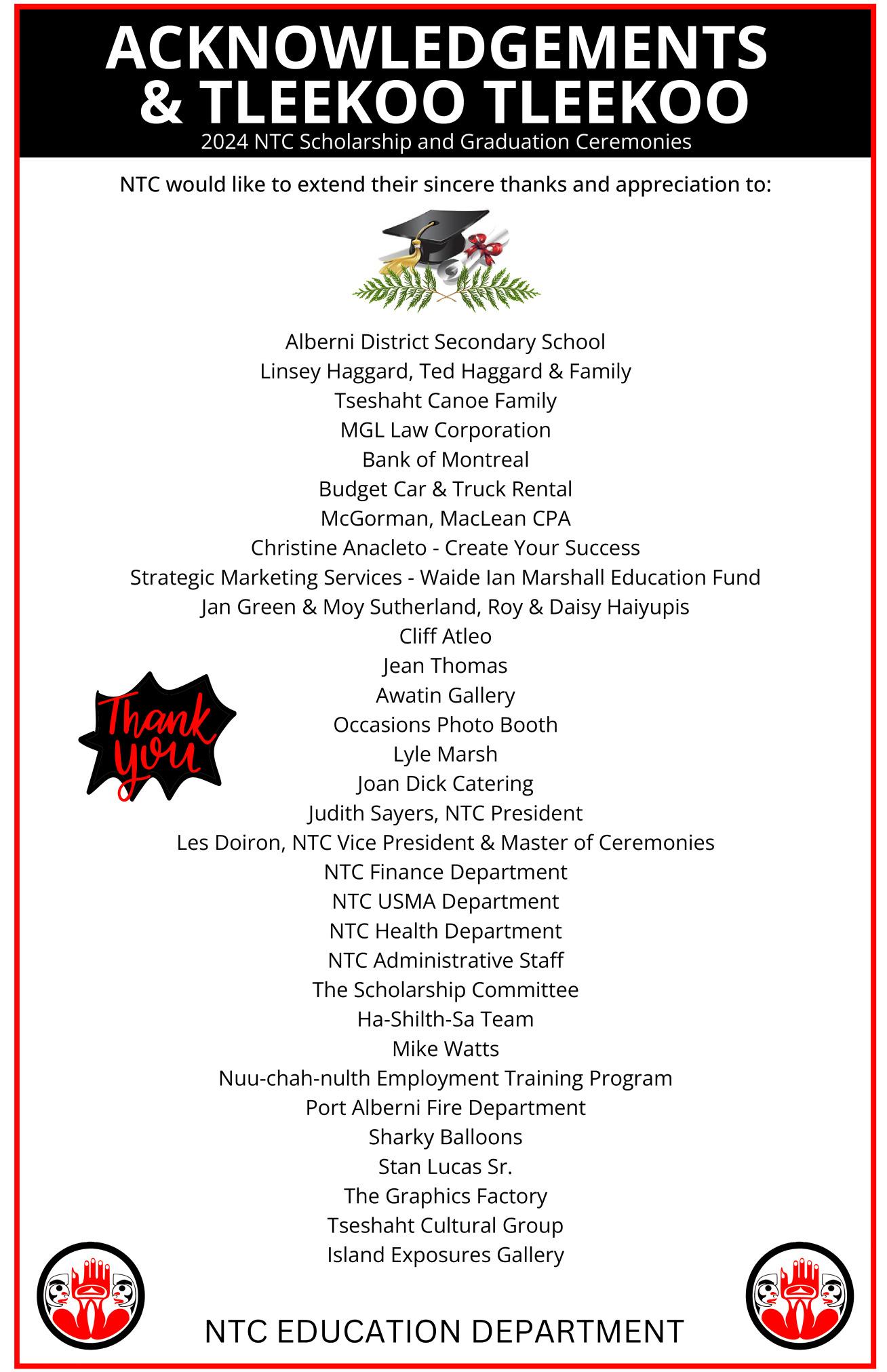




By Eric Plummer Ha-Shilth-Sa Editor
Vancouver, BC - B.C.’s fish farms now have five years to get open net-pens out of the water – a federal directive that has evoked opposing reactions from coastal First Nations.
Since 2019 a deadline has loomed over the industry, when Prime Minister Justin Trudeau gave a mandate to have a plan by 2025 to transition away from the open-net pens that have long been the standard for finfish aquaculture. On June 19 it finally became clear where that plan will lead, as Fisheries and Oceans Canada announced that all open net pens will be banned in British Columbia waters as of June 30, 2029.
For years opponents to finfish farming have feared that the close proximity in net pens allow sea lice and other pathogens to propagate, spreading to wild salmon as they migrate past the sites.
Fisheries and Oceans Canada said the decision was made to protect wild stocks “that face unprecedented threats to their survival”.
“The government is firmly committed to taking concrete steps to protect wild salmon,” stated Canada’s Minister of Fisheries Diane Lebouthillier.
There are currently 85 active finfish licences on the B.C. coast, most of which operate in Nuu-chah-nulth territory from Barkley Sound in the south up to Kyuquot. Sixty-six of B.C.’s sites are seeking to have their licences renewed on June 30, at which time DFO will grant another five years for these farms until the ban takes effect in 2029. These licences are being renewed with stricter conditions to manage sea lice and monitor any interactions with marine mammals, according to DFO.
This spring the First Nation Wild SalmonAlliance published a list of over 120 nations, comprising most Indigenous communities in B.C., that want net pens out of the ocean. From Nuu-chah-nulth territory this list includes the Ditidaht, Tseshaht and Uchucklesaht First Nations.
Following the government’s announcement the Hesquiaht First Nation added its voice to those opposed to the industry, saying that an open net-pen ban in 2029 isn’t soon enough.
“The announcement today is a testament to the harsh reality that government continues to be willing to sell out to industry despite the horrific impacts it is having on our environment and precious waters; the same waters and resources that have sustained us since time immemorial,” stated Hesquiaht Chief Councillor Mariah
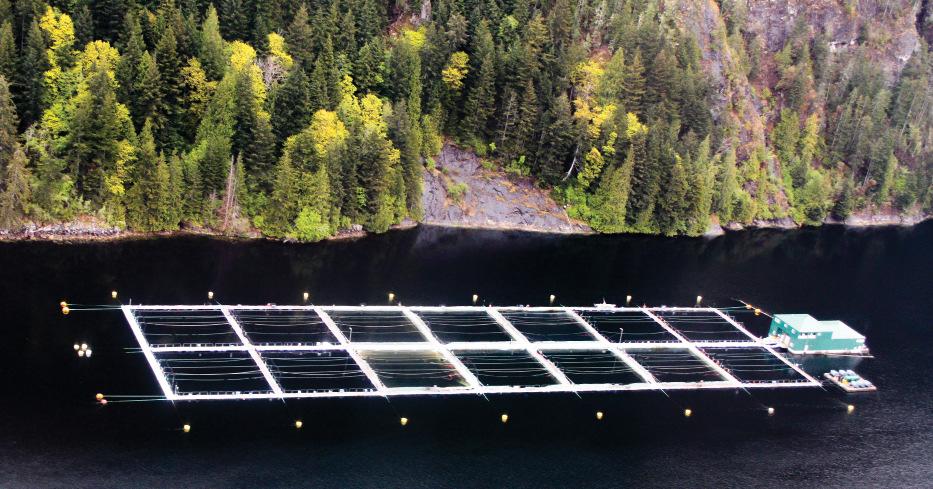
Charleson in a press release. “Five more years of pollution in our precious waters is not what I was expecting from today’s announcement.”
But First Nations with a stake in the industry aren’t pleased with the announcement either.As the news spread the Coalition of First Nations for Finfish Stewardship held a press conference in Vancouver on June 19, stressing that the 2029 ban is coming from activists and politicians that are out of touch with the ties fish farms have to coastal communities.
“Vancouver is not British Columbia,” said the coalition’s spokesperson Dallas Smith, who is also acting chief for the Tlowitsis Nation. “There’s 5,000 people that depend on employment from this sector right now…500 of them are directly employed in remote First Nations communities.”
“Our rights have been dismissed in favour of a privileged, Liberal, urban riding political narrative,” saidAhousaht Tyee Ha’wilth Hasheukumiss, Richard George. “There has not been adequate consultation with my nation. I requested many meetings and sent many letters, including to the Prime Minister, asking to be heard on this issue.”
For over a decadeAhousaht has had a protocol agreement with Cermaq for the operation ofAtlantic salmon farms in its territorial waters. Valued by the nation at $6 million annually, this agreement brings specific environmental standards for the sites, employment opportunities, educational supports, transportation and other benefits. Over 20Ahousaht mem-
bers work at Cermaq locations in Clayoquot Sound.
“The potential impacts to my community and citizens’well being is severe,” said Hasheukumiss of how the net pen ban will affectAhousaht’s on-reserve community. “Twelve hundred people live there; there’s 200 jobs in my nation.”
Also present at the coalition’s press conference was Simon John, chief councillor of the Ehattesaht/Chinehkint First Nation. He expressed that the federal decision was another example of the government dismissively putting First Nations people “in a box”.
“My heart is hurt a little bit more today because of that,” said John. “Living my life to the greatest extent that I have and utilizing all the resources that have value in my territory, the bearing on it is that the government still owns it, they own it all.”
In recent years British Columbia has become an outlier on the Pacific northwest as the only jurisdiction to allow industrial-scale fish farming. In 2022 Washington turned its back on the industry with an executive order to ban commercial salmon farms in the state’s waters.
But in it’s June 19 announcement the federal government didn’t close the door on fish farming, noting that the 2029 timeline will promote “more sustainable aquaculture practices”.Adraft of the government’s transition plan away from open net pens is expected by the end of July, which will identify “economic supports for the use of innovative and clean aquaculture technology”.After existing licences are renewed for another five
years, DFO will only consider land-based or aquatic closed-containment farms, which could operate for a nine-year term. It remains to be seen what will be viable, as net pens have long been the industry standard on the B.C. coast. Cermaq has trialed semi-closed containment pens on Vancouver Island’s west coast that block all interaction with wild salmon by using an enormous bag composed of a synthetic, non-permeable material. Oxygen and water are pumped into the semi-closed site from a depth of 23 metres, an additional measure that requires a considerable amount of power at remote locations.
Due to these demands, open-net pens have remained the practical standard for the industry. Brian Kingzett, executive director of the BC Salmon Farmers Association, said the government fails to understand how difficult a transition to other approaches would be.
“This focus on unproven technology jeopardizes the sector’s ability to fulfill agreements with rights-holder First Nations and will cause further harm to our communities,” he stated in a release.
“We do not have the land or the supporting power infrastructure to do this,” said Hasheukumiss of the possibility of transitioning from open-net pens. “This is not even logistically possible.”
“Only our collective Ha’wiih have right to decide the title and rights in our Ahousaht territory,” he added. “We will be allowing for a more realistic approach of a 10-year transition plan in my Ḥahuułi.”

Māori visitors join EhaÅesaht relatives at the village site where their ancestors first met hundreds of years ago
By Denise Titian Ha-Shilth-Sa Reporter
Zeballos, BC – The Smith family of Ehattesaht have heard a story that’s been passed down the generations from grandparent to grandchild. It is the story of three men that traveled a great distance, finally paddling ashore in Ehattesaht territory where they were welcomed and invited to stay.
“When I was a teenager, my Grampa Mo Smith told me the story about the Māori coming to live with us,” said Ernie Smith, now an elected councillor at Ehattesaht/Chinehkint. “He didn’t say when it was, but he said there were three of them and they stayed for three years.”
Nobody knows how far back the story goes – but it seems it stretches back to a time before contact with European explorers.After three years, the Māori men were set up with new canoes and provisions. They left to cross the ocean back to their New Zealand home, taking their Ehattesaht wives along.
Beginning in the 1990s, artistsArt Thompson and Tim Paul went to New Zealand to present a totem pole. Paul is a first cousin to Ernie Smith. While he was in New Zealand he shared the story that his cousins grew up hearing on Vancouver Island.
The story goes that three Māori men landed at the village of tiławis, also known as Yellow Bluff on the north shore of Esperanza Inlet. Smith says this is where his family comes from, they are tiłaawisʔatḥ.
During the trip to New Zealand in 1990 the Nuu-chah-nulth delegation learned that there is a similar story that’s been shared over the generations on the Māori side.
“The story was carried forward on both sides of the ocean for generations,” said Smith.
Years later, Dr. Lily George, a Māori woman, was writing a paper on the pole that Tim Paul andArt Thompson made. During her work George connected with
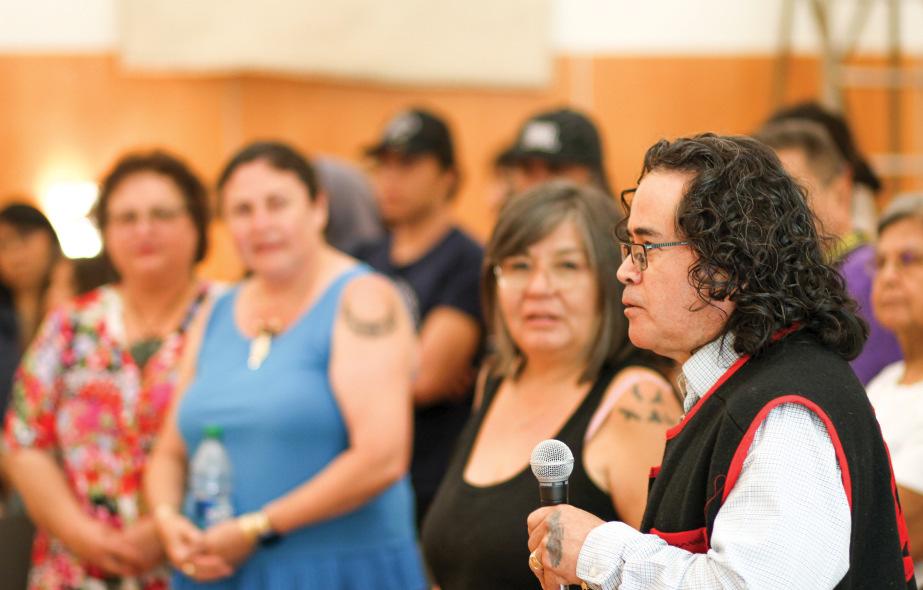
Ernie’s cousin Tim Paul, telling him she hoped that they are related. It turns out that they are.
George’s mother had tested withAncestry DNAbefore her passing. Both Dawn and Ernie tested their DNA, and their results came with surprises.
“That’s when we found out we had Māori blood,” said Ernie.
Both he and Dawn have small percentages of Māori and Hawaiian blood, which is consistent with the oral history.
Ernie said he knew back in 2015 that he had Pacific Islander DNA, both Māori and Hawaiian. Dawn’s recentAncestry DNAtest shows she has one per cent Hawaiian heritage.Among Ernie’s DNA matches was Lily George’s mother, Manu Reti, listed as a possible fourth cousin.
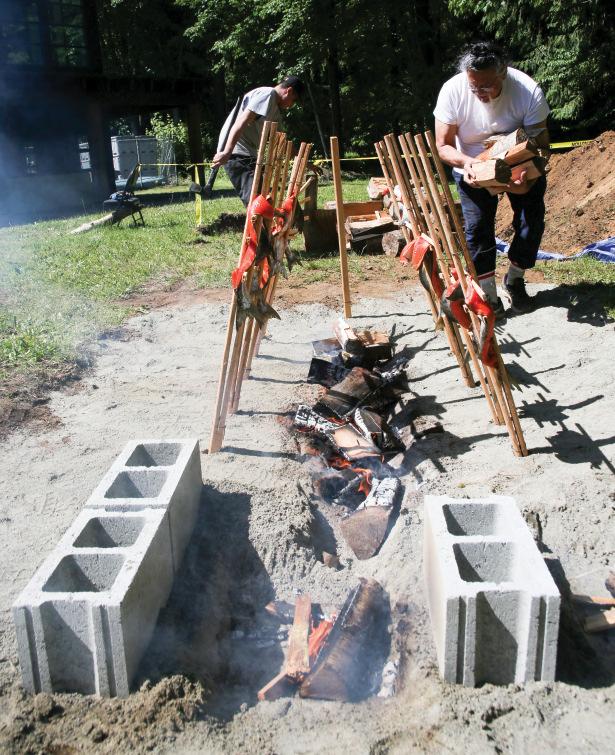
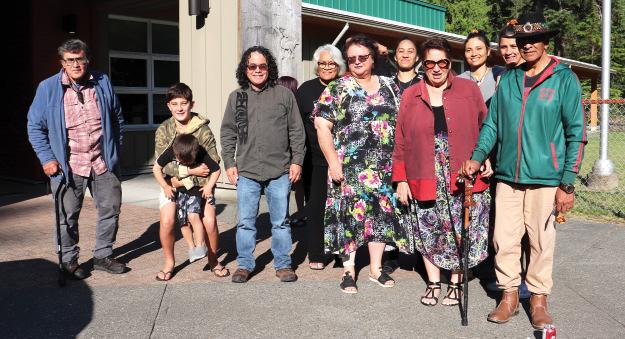
Using online tools available to the public, if Ernie Smith and Manu Reti are indeed fourth cousins, they share a set of great-great-great grandparents and they go back five generations. Since the times between generations are variable, based on what age parents are when they have babies, five generations ranges from 100 to 200 years. This could mean that the Māori may have landed on the Ehattesaht beach anywhere from the mid 1700s to the mid 1800s.
The connection is an old one and at the edge of no longer registering as matches for younger Smith and Māori generations. So, it is timely that this discovery was made when it was.
“I am really happy to have this connection. The Smith family has expanded hugely,” said Ernie Smith.
And it proves that oral history is strong and accurate.
“I’m really grateful for them, passing the stories down, this has proven to be accurate, 100 per cent, in this case,” he said.
The people of Ehattesaht hosted a small group of Māori visitors from New Zealand in Zeballos on June 18.As people sat down to dinner Ernie Smith told the people about the Māori visitors that arrived on Ehattesaht shores more than 200 years ago. Stranded on Vancouver Island for three years, the three Māori men lived with the Ehattesaht, taking Ehattesaht wives and starting families.
Three years later, ocean conditions were favorable for their return trip to their homeland thousands of miles across the
Pacific Ocean. They left the village with their wives aboard new canoes and all the supplies they needed, never to be seen again.
But the stories remained, passed down the generations in Nuu-chah-nulth and in Māori communities.
During their stay in Ehattesaht territory, the 11 Māori guests stayed at Esperanza and visited the ancient village of tiławis, retracing the steps their ancestors took more than a century ago. The group spent three days in Ehattesaht territory.
“Lily really wanted to go to Zeballos and get to know the homelands,” said Dawn. “It was a pretty powerful experience – emotional.”
The carved panels outside the Zeballos School are an artists’depiction of the historical Māori visit.
“Uncle Earl (Smith) wrote the story down and Ehattesaht artist Tim Smith used the story as inspiration for the carved panels outside the school in Zeballos,” said Ernie.
The Smiths and their Māori relatives posed outside the school, in front of those panels before they left for Esperanza.
Both Ernie and Dawn plan to make a trip to New Zealand in the next year or so. Dawn works with Tim Paul and his educational culture society, Ticmup. They are working to create cultural exchange opportunities for Nuu-chah-nulth youth, allowing them to connect with the Māori.
“This is so exciting, to have Māori in our territory. They’re our family, our blood,” said Ernie Smith.
Most of TFL 54 is now under new conservancies, aligning with Tla-o-qui-aht and Ahousaht’s land-use visions
By Eric Plummer Ha-Shilth-Sa Editor
Large portions of forest in Clayoquot Sound became protected this month, a development that the Tla-o-qui-aht First Nation is calling a “major step” in the provincial government recognizing its Tribal Parks.
On June 18 the province announced 76,000 hectares of conservancies in Clayoquot Sound. Effective June 26, these protected areas now comprise almost 60 per cent of what was formerly under a forestry tenure tied to TFL 54, the only tree farm licence in Clayoquot Sound.
The 10 new sections of protected land are within the traditional territories of the Tla-o-qui-aht andAhousaht First Nations. These areas of Crown land contain old growth forest and habitat for endangered and threatened species.
“The survival of these precious forests will allow future generations to continue practicing our cultural ways, will stabilize the climate in this region, and will provide much needed habitat for a diversity of species,” stated the Tla-o-qui-aht First Nation in a press release.
The newly protected areas align with theAhousaht and Tla-o-qui-aht’s land use visions, according to province. The establishment of the conservancies follow a period in which sections of Clayoquot Sound’s old growth forest have been temporarily protected under a deferral since 2020.
The tenure for TFL 54 is currently held by Ma-Mook Natural Resources, which is owned by a partnership of theAhousaht, Tla-o-qui-aht, Hesquiaht, Toquaht and Yuułuʔiłʔatḥ First Nations. Payment for removing the Crown land from the tenure is being funded by Nature United, the Canadian affiliate of the world’s largest conservation organization.
The conservancies mean that commercial logging, mining and large-scale hydroelectric projects will be prohibited in the areas.Approximately 55,000 hectares of TFL 54 will remain for forestry purposes.
The tree farm licence is undergoing a reconfiguration “that supports predictable fibre flow through First Nation-held tenures in the future,” according to the province.
“These conservancies are welcomed as part of a broader vision for implementingAhousaht title and rights, generating economic opportunity through a forest carbon project and community forestry, and securing social and cultural access to forest resources,” statedAhousaht Hereditary Representative TysonAtleo.

Saya Masso, Tla-o-qui-aht’s natural resource manager, speaks in the First Nation’s Meares Island Tribal Park.
The Tla-o-qui-aht First Nation stated that the new protected areas are a “crucial part of our vision to remove competing tenures from our title lands and restore our customary stewardship traditions in a modern context.”
“The establishment of conservancies will ensure that clear-cut logging has no place in these important old-growth forests,” stated Tla-o-qui-aht Chief Councillor Elmer Frank in a release from the province. “This protection by British Columbia brings B.C. laws into better alignment with Tla-o-qui-aht laws.”
Avital part of the First Nation’s stewardship are its Tribal Parks, which began in 1984 with the protection of old growth on wanačas hiłhuuʔis (Meares Island) from being logged by MacMillan Bloedel. In 1985 a court injunction was put in place to protect the island from this activity, an order that remains in place today. Other parts of the First Nation’s territory were declared Tribal Parks in 2014.
“The same title exists on the hiisawista (Esowista) peninsula, ʔaʔukmin (Kennedy Lake watershed), and ḥiłsyakƛis ʔunaacuł (Tranquil River watershed), and the islands of Tla-o-qui-aht haḥuułi (traditional territory),” stated the Tla-oqui-aht.

Although more of Clayoquot Sound will be protected from being harvested, Minister of Forests Bruce Ralston said the conservancies will bring more clarity for forestry, while giving “our industry partners confidence in the future of forestry.”
“Conserving nature and creating sustainable jobs are important objectives that we can achieve to secure a stronger future for everyone,” he added.
In recent years the volume of lumber being harvested in B.C. has declined dramatically – particularly old growth. Since
2021 the province’s overall harvest has declined from 45 million cubic metres to 32.4 million last year. From 2015 to 2022 the area of old growth forest harvested has dropped by 52 per cent, declining from 66,526 hectares to approximately 33,000.
Meanwhile 2.42 million hectares have been either deferred from harvest or permanently protected since November 2021, adding to the 3.8 million hectares that were already conserved.


New conservancies bring memories of the Meares Island standoff in 1984 with tenure holder MacMillan Bloedel
By Nora O’Malley Ha-Shilth-Sa Contributor
Tofino, BC - Sitting side-by-side, Tla-oqui-aht First Nation elder Moses Martin andAhousaht Ha’wilth Maquinna (Lewis George) gazed thoughtfully at the scene unfolding at Tofino’s Village Green on June 21, as young dancers welcomed family and guests to a celebration that’s been a long time coming.
Forty-years after declaring Meares Island a tribal park under Nuu-chah-nulth law, the provincial government is finally recognizing Indigenous authority of the so-called Crown lands that were colloquially known as Tree Farm Licence (TFL) 54. On June 18, the province announced 76,000 hectares of conservancies in Clayoquot Sound. When these protected areas come into effect on June 26, they will comprise almost 60 per cent of what is currently under a forestry tenure tied to TFL 54.
“It feels really, really good,” said Maquinna of the new conservancies, reflecting on the Meares Island standoff of 40 years ago. “I was telling Moses that I was really proud of what he did. They had their chainsaws, they were starting to clearcut that day. My dad was there at the same time to stop them. Two people from Ahousaht and Tla-o-qui-aht. The other 12 Nuu-chah-nulth tribes jumped right in with support and a lot of other people jumped in with support in the fight for Meares.”
In 1984, Martin made history for leading a blockade that quashed industrial logging giant MacMillan Bloedel’s plans to cut the big trees on Meares Island, a place located 10-minutes by boat from Tofino where visitors can admire some of the oldest Western red cedar trees on Earth.
Martin’s actions led to the creation of Canada’s first-ever tribal park and to a court injunction that halted the logging of Meares. He says the idea of declaring Meares Island a tribal park came out of what was also happening up in Haida Gwaii between the Haida people and loggers.
“They were doing the same thing up in Haida Gwaii, but they no longer needed to call it a tribal park because of their discussion with Canada for a national park,” Martin recalls.
Haida’s blockades and fight to save old-growth forests resulted in a landmark conservation agreement between Haida and Canada’s federal government.
While Martin was applauded twice during the June 21 event for his key role in

saving Meares, he reinforced the fact that protecting the big trees was very much a group effort.
“It’s something we were all a big part of, not just us, not just myself. That’s kind of what I did as a community leader and elected chief, was to build relationships with our municipality and our neighbouring tribes.At the time when we needed it, we all came together with the same thing in mind that we were going to find a way to protect Meares Island,” said Martin.
The tenure for TFL 54 is currently held by Ma-Mook Natural Resources, which is owned by a partnership of theAhousaht, Tla-o-qui-aht, Hesquiaht, Toquaht and Yuu u i ath First Nations. Payment for removing the Crown land from the tenure is being funded by the environmental group Nature United, who committed $40 million to supportAhousaht and Tla-oqui-aht with the transition from commercial forestry to a conservation economy.
MP Gord Johns attended the June 21 celebration in Tofino.
“The financing is to be able to help exercise their renewed declaration and the vision of the Hawiih and the muscim of Tla-o-qui-aht andAhousaht,” said Johns.
“For them to be able to implement their land use vision, they require resources.
This is just the beginning. Canada and the province of B.C. and all of us need to do much more.”



“This is just a first step in securing an agreement with the nations for conservation so that they can fulfill their vision, but it doesn’t take away their ability to exercise their rights for self-determination. It does ensure that any development that happens in their ha-houlthee requires free, prior and informed consent,” Johns continued.
The Meares Island Tribal Park Declaration was read aloud in both English and Nuu-chah-nulth language during the festivities at Tofino’s Village Green. Saya Masso, Tla-o-qui-aht’s Natural Resources manager, said it is oral tradition to read documents aloud and have people witness.
Martin spoke about the loss of language
due to residential schools.
“There are 1,400 people in the tribe that I come from. Only 10 of us are fluent speakers. It was something special (to hear the declaration in Nuu-chah-nulth language). The elders are working to keep our language alive,” said Martin.
Maquinna went on to tell the Ha-ShilthSa newspaper thatAhousaht is trying to raise funds to buy all the lands back in their territory.
“It will be back in our hands, so corporations can’t come in and clearcut,” said Maquinna. “With Tla-o-qui-aht, their fight is on the same level as ours, but they have to fight for their territories. We support them, but we are careful to make sure we are not stepping on toes.”

Ha-Shilth-Sa newspaper is published by the Nuu-chah-nulth Tribal Council for distribution to the members of the contributing First Nations, as well as other interested groups and individuals.
Information and original work contained in this newspaper is protected by copyright and may not be reproduced without written permission from:
Nuu-chah-nulth Tribal Council
P.O. Box 1383, PortAlberni, B.C. V9Y 7M2.
Telephone: (250) 724-5757
Fax: (250) 723-0463
Web page: www.hashilthsa.com
facebook: Hashilthsa Ntc
Non-Nuu-chah-nulth,Ahousaht, Ehattesaht,Toquaht and Ucluelet members are subject to a yearly subscription fee of $40 in Canada, $50 in the US and $60 for overseas. Payable to the Nuu-chah-nulth Tribal Council
Manager/Editor/Reporter
Eric Plummer (Ext. 243) (250) 724-5757 Fax: (250) 723-0463 eric.plummer@nuuchahnulth.org
Reporter
Denise Titian (Ext. 240) (250) 724-5757 Fax: (250) 723-0463 denise.titian@nuuchahnulth.org
Reporter
Alexandra Mehl (Ext. 286) (250) 724-5757 Fax: (250) 723-0463 alexandra.mehl@nuuchahnulth.org

Audio / Video Technician
Mike Watts (Ext. 238) (250) 724-5757 Fax: (250) 723-0463 mike.watts@nuuchahnulth.org
EditorialAssistant
Holly Stocking (Ext. 302) (250) 724-5757 Fax: (250) 723-0463 holly.stocking@nuuchahnulth.org
Please note that the deadline for submissions for our next issue is July 12, 2024
After that date, material submitted and judged appropriate cannot be guaranteed placement but, if material is still relevant, will be included in the following issue.
In an ideal world, submissions would be typed rather than hand-written. Articles can be sent by e-mail to holly.stocking@nuuchahnulth.org (Windows PC).
Submitted pictures must include a brief description of subject(s) and a return address.
Pictures with no return address will remain on file.Allow two - four weeks for return.
Photocopied or faxed photographs cannot be accepted.
Although we would like to be able to cover all stories and events, we will only do so subject to:
- Sufficient advance notice addressed specifically to Ha-Shilth-Sa.
- Reporter availability at the time of the event.
- Editorial space available in the paper.
- Editorial deadlines being adhered to by contributors.
Ha-Shilth-Sa will include letters received from its readers. Letters MUST be signed by the writer and have the writer’s full name, address and phone number on them. Names can be withheld by request.Anonymous submissions will not be accepted. We reserve the right to edit submitted material for clarity, brevity, grammar and good taste. We will definitely not publish letters dealing with tribal or personal disputes or issues that are critical of Nuu-chah-nulth individuals or groups. All opinions expressed in letters to the editor are purely those of the writer and will not necessarily coincide with the views or policies of the Nuu-chah-nulth Tribal Council or its member First Nations. Ha-Shilth-Sa includes paid advertising, but this does not imply Ha-Shilth-Sa or Nuu-chah-nulth Tribal Council recommends or endorses the content of the ads.

By Nora O’Malley Ha-Shilth-Sa Contributor
PortAlberni, BC - The Dock+, a thriving seafood hub in the heart of Nuu-chahnulth territory, has secured roughly $4 million in funding to break ground on an exciting 3,000-square-foot expansion project that includes the integration of High Pressure Processing (HPP) technology.
Apartnership between the PortAlberni PortAuthority (PAPA), Nova Harvest Ltd. and Huu-ay-aht First Nations (HFN) Fisheries LP, the expansion project received a $2,995,786 grant from the B.C. Ministry ofAgriculture and Food, with the three partners contributing a combined $1 million in equity to top the project off.
HFN Group of Businesses Chief Executive Officer Patrick Schmidt says The Dock+ joint venture builds on a threeyear partnership with oyster farming company Nova Harvest.
“It takes time to grow them. Right now, we want to target this year to have eight million oysters in the water,” said Schmidt. “We’ve ramped up from one million (oysters) two years ago. The idea would be those would start being harvested in 18 to 24 months. There’s kind of a lag time between seeding to farming to processing.”
J.P. Hastey, president of Nova Harvest Ltd., says the goal is to position oysters so that they are more broadly consumed and available to retailers.
“We’re growing enough product on the farms so that you can build out that processing capacity for getting oysters into new markets,” said Hastey.
To build a more efficient oyster processing plant, Nova Harvest zeroed in on a $1.3 million HPP commercial food processing machine imported from Sweden that has the ability to shuck oysters.
“It can apply up to 60,000 PSI, what is also known as cold pasteurization,” explained Hastey. “It doesn’t disrupt any physical qualities, it maintains all the nutritional qualities and you don’t have to add any mechanical or chemical components when processing. It’s simple, you press them under pressure and it releases and that separates the shell from the tissue.”
“It’s not just oysters that this machine

Dock+ has secured roughly $4 million in funding to break ground on a 3,000-square-foot expansion project that includes the integration of High Pressure Processing technology.
is built for,” Schmidt went on to note. “Most of the salsas that you eat have gone through this. It kills pathogens on food. We envision that this machine will be able to service other food products. If someone comes up with something and they want to try it out, we’re game.”
They told the Ha-Shilth-Sa that The Dock+ will be one of the only locations in Western Canada to own a HPP commercial processor.
“This will be the first one in Western Canada that is a dedicated seafood unit,” adds Hastey.
Shelley Chrest, PAPA’s chair of the Board of Directors, expressed gratitude to community partners for their instrumental support in shaping The Dock+ project.
“We want to acknowledge the support of our community partners, including the City of PortAlberni, Island Coastal Economic Trust, and our local MLAand MP in developing The Dock+,” said Chrest in a media release. “This expansion will be instrumental in actioning the PortAuthority’s vision of developing and supporting a local and regional seafood hub, while continuing to support small businesses and providing well-paying jobs in the community.”
Hastey says that once the HPP machine is up and running, it will likely create employment for over 20 people.
“Having the (HPP machine) will allow opportunities in shellfish aquaculture to develop and expand. Having that capac-
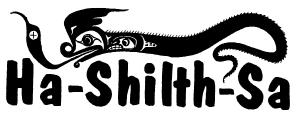
Ha-Shilth-Sa belongs to every Nuu-chah-nulth person including those who have passed on, and those who are not yet born.Acommunity newspaper cannot exist without community involvement. If you have any great pictures you’ve taken, stories or poems you’ve written, or artwork you have done, please let us know so we can include it in your newspaper. E-mail holly.stocking@nuuchahnulth.org. This year is Ha-Shilth-Sa’s 50th year of serving the Nuu-chah-nulth First Nations. We look forward to your continued input and support. Kleco! Kleco!
ity in PortAlberni is really going to be important for anybody in the aquaculture production side. It’s a piece of machinery that adds a strong foundation to the sector,” he said.
PAPA’s Manager of Marketing, Communications and Public Relations Carmela Ferro says The Dock+ expansion will be great for the community.
“It’s keeping jobs locally, it’s allowing people to stay close to home and creating those economic opportunities,” said Ferro.
PAPA, HFN Fisheries and Nova Harvest have an opening target of spring 2025 for the expansion project.
In addition to being a seafood processing facility, The Dock+ also rents a commercial kitchen.
“If you have an idea for a start-up business that involves food, The Dock+ is open for you to make your dreams come true — big and small scale,” Ferro notes. “Even if someone wants to make pizzas for them to freeze for themselves and they need a bigger kitchen, they can become a member.”
Annual membership is $100 for new members and it’s $18.50 per station per hour during prime hours (9a.m. to 3p.m.) and $15.50 per station per hour during non-prime hours.
Anyone interested in learning more is encouraged to visit: https://thedockplus. ca/.
The advertiser agrees that the publisher shall not be liable for damages arising out of errors in advertisements beyond the amount paid for space actually occupied by the portion of the advertisement in which the error is due to the negligence of the servants or otherwise, and there shall be no liability for non-insertion of any advertisement beyond the amount paid for such advertisements
For the third year in a row, volunteers gather a surprising amount of debris from the shores of Vargas Island
By Denise Titian Ha-Shilt-Sa Reporter
West Coast Vancouver Island – Volunteers headed up by a team from BC Marine Trails (BCMT) descended on Vargas Island for the third year in a row to collect trash that has either been left there or washed ashore.
According to Sam Cutcliffe, BCMT communications and stewardship coordinator, 12 Super Sacks of marine debris were collected over three days in late May.
“Vargas Island offers a powerful lesson on marine debris,” said Cutcliffe. “When you first arrive at a remote beach like Ahous Bay, it appears pristine. However, collecting five Super Sacks of debris in a single day reveals how pervasive and hidden the problem truly is. Spotting one washed up water bottle often means there are hundreds more hidden along the shore.”
ASuper Sack, also known as FIBC (Flexible Intermediate Bulk Containers), are huge woven bags. They typically have a weight capacity of 2,000 to 3,000 pounds.
Cutcliffe says his organization hosts stewardship events where they select a beach that typically has a provincial campsite. They rally volunteers to come out for a day or two of beach cleaning. The events not only collect trash, keeping it out of the sensitive ecosystem, but also teach users of the parks and beaches to clean up after themselves.
Vargas Island has a BC Parks site. In its third consecutive year being cleaned Cutcliffe has noticed that the work is getting easier there.
“This year there’s been a significant improvement, “said Cutcliffe.
In the first years they were removing half-buried large items like barrels. This year it’s mostly small stuff that has been collected.
Volunteers typically clean drink contain-

ers, fishing debris and dock floats from beaches.
Alot of coordination goes into beach cleaning events. Not only is there a call for volunteers from schools and tourism businesses, but grants need to be applied for to pay for the cost of beach cleaning. Once all that trash is collected, the massive Super Sacks need to be transported from the beach to a facility where the

materials are sorted and recycled.
The Western Canada Marine Response Corporation, based in PortAlberni, picked up the collection of debris off of Vargas Island in early June. The debris will end up in the Ocean Legacy Depot in Ucluelet where it will be sorted and recycled or disposed of.
Students from bothAhousaht and Ucluelet’s secondary schools have or will take part in this season’s beach-cleaning events.
Cutcliffe says the biggest impact of the beach cleaning projects could be getting youth interested and involved.
“Getting kids interested and passionate – caring about these causes for the rest of their lives is what’s important,” said Cutcliffe.
BCMT is a non-profit charitable organization that works to secure long-term public access to the B.C. coast. They work with First Nations and other stakeholders to build, promote and protect
the province’s network of beaches and marine trails while encouraging minimal impact on the coastline.
“Collaboration with First Nations is essential in our work, particularly in developing a marine trail network that respects Indigenous rights and title,” stated the organization.
BCMT says they recognize that past mapping of recreational sites lacked engagement with coastal First Nations.
“We’re now reviewing all known sites with each coastal First Nation, aiming to transform coastal recreation into a practice that respects Indigenous rights and title,” stated BCMT.
This year’s beach cleaning project was funded in part by a grant throughAthletic Brewing Co’s ‘Two for the trails’ initiative.Athletic Brewing Co. is a US-based brewery that creates premium non-alcoholic beer. Their Two for the Trails program has donated more than $4 million USD to restore hiking trails in the US and Canada.
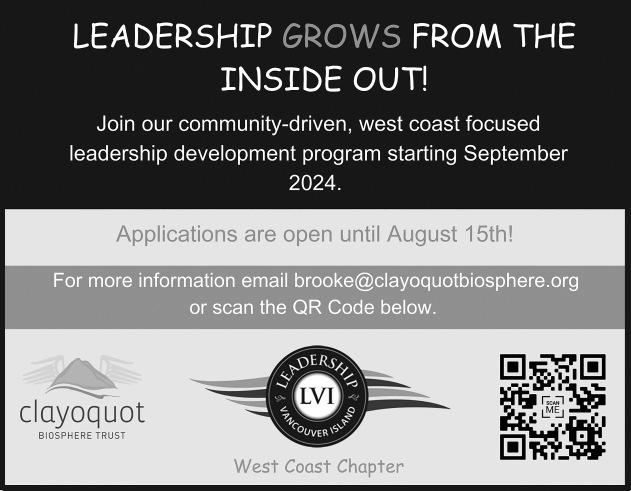
The coast has seen a 90 per cent decrease in canopy-forming kelp due to warming temperatures and sea urchins
By Karly Blats Ha-Shilth-Sa Contributor
Ateam of researchers from the University of Victoria (UVic) and the Bamfield Marine Sciences Centre are working closely with coastal First Nations in attempts to regrow kelp forests.
The kelp restoration project is supported by a $3.68 million research grant from Fisheries and Oceans Canada under theAquatic Ecosystems Restoration Fund. Now in the second year of a four-year project, researchers are growing kelp in nurseries at Bamfield. They are testing different kelp culturing and planting methods for B.C.’s two species of canopy-forming kelp—giant and bull kelp—in coastal waters and are measuring their hardiness in different conditions. Kelp forests support coastal biodiversity, draw down atmospheric carbon and improve water quality. But ocean warming has placed the cold water-loving ecosystems in jeopardy.
Researchers have planted kelp in different locations in Barkley Sound, where the Bamfield Marine Sciences Centre is located and off Hornby Island, including Baynes Sound and Ford’s Cove, in the Salish Sea. They’re studying different species’varying rates of growth, tolerance for different temperatures, the sizes of biomass and even their hold-fasts, which secure plants to rocks.
“I like to think of kelp forests as the coral reef of colder oceans, so they’re sort of one of the most critical habitats for shallow coastal critters,” said Dr. Jasmin Schuster, program manager of the kelp rescue initiative with the Bamfield Marine Sciences Centre. “They support the whole food chain, even critters that don’t eat kelp themselves. They’re also really prolific oxygen producers.”
Schuster said B.C.’s coastal waters have seen about a 90 – 95 per cent decrease in canopy-forming kelp, which varies slightly by region, due to increasing temperatures and sea urchins overeating
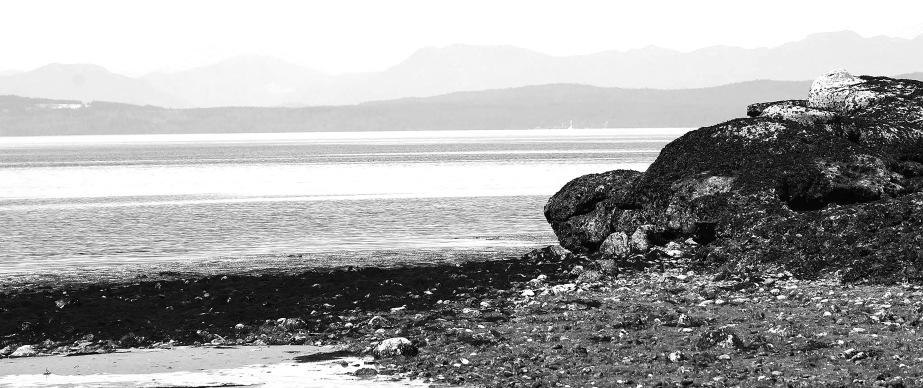
the plants.
The goal of the researchers is to develop a roadmap to recovery for kelp forests being destroyed by ocean heat waves and over-grazing by sea urchins, and to develop the science for kelp reforestation at large scales.
“We’re running several experiments this year in Barkley Sound and the north Salish Sea…over the next couple of years it’s all about scaling up,” said Schuster, who hopes to restore kelp at a larger scale each year. “We’re focused specifically on the two species of canopy formers that we have on this coastline.”
Giant and bull kelp grow on the seafloor all the way to the ocean’s surface.
“When you’re out on a boat you can see them floating off the water. The individual kelps can grow maybe 30 metres tall in some cases but certainly well over 10 metres,” Schuster said.
Schuster added they’re working with the Huu-ay-aht First Nations on this project and are in the process of organizing a cultural harvest to remove some sea urchins from the area.
According to a news release from UVic, work done by the project’s First Nations

liaison, Connie Crocker, has been vital to building relationships with First Nations to integrate knowledge, needs and capacity about kelp restoration and its importance to their cultures and ongoing needs.
“The roadmap to kelp recovery is through awareness. It’s all about awareness—there’s strength in numbers. We need the public behind us,” Crocker said in the release. “Alot of people are concerned about climate change and the state of our oceans. It’s urgent and the ocean is in peril. If only people knew about kelp decline, we could make some headway.”
Additional research will include a partnership with Vancouver Island University at the Deep Bay Marine Field Station on
Vancouver Island’s east coast, and the team is in the process of installing two new nurseries at Bamfield. It’s also developing a kelp “glue” so when researchers are “out-planting,” new kelp aren’t washed away.
“It is very ambitious, but the urgency of this problem drives us to commit to these large goals,” said Sean Rogers, Bamfield Marine Sciences Centre director. “Even if the project does not achieve reforestation in four years, it will advance knowledge of how to do so, through rigorous scientific trials, and in doing so produce a framework—the formula that is currently lacking—for recovery.”

Revised system gives around-the-clock alerts, replacing an old method limited to calls during business hours
By Karly Blats Ha-Shilth-Sa Contributor
Anew notification system that alerts First Nations in B.C. when oil and other hazardous chemicals are spilled within their territories has just launched and is currently being rolled out province-wide.
The new system ensures that First Nation communities and individuals receive spill alerts quickly, 24/7, and that notifications are directly relevant to their selfidentified needs.
The spill notification system was developed through a collaboration between 12 First Nations on the northern Pacific Coast and the B.C. government’s Ministry of Environment and Climate Change Strategy. Coastal First Nations-Great Bear Initiative has coordinated the collaboration.
According to a press release from Coastal First Nations-Great Bear Initiative, the system leverages the technology ofAlertable. This is the app used by many local governments to send critical alerts to residents, businesses and visitors for extreme weather events such as floods and fires, as well as for community notices such as water advisories.
First Nations played a key role in guiding the configuration of the original technology and related notification procedures. Early on, participating First Nations led a virtual exercise to identify gaps and challenges in the old system. They also participated in a pilot project to test and refine the technology.
“Rapid and efficient notification, as with any emergency or disaster, can significantly reduce impacts,” said Kaitlin Minvielle, emergency program coordinator with the Nuu-chah-nulth Tribal Council.
“Early notification not only enhances collaboration between nations, the provincial government and spill identifiers but also allows nations to safeguard culturally significant sites that may not be widely known.”
With this new system, First Nation governments are able to define their geographic areas of interest for receiving notifications, and community members can sign up to receive real-time notifications by phone, text, or email when incidents occur.
“Given that we have early warning no-


tification systems for other disasters and emergencies, such as earthquakes, a spill response notification system is clearly necessary,” Minvielle said. “Coastal First Nations are particularly vulnerable to spills, which can lead to food loss, damage to culturally significant sites and economic impacts.”
Minvielle added that while the development of the new app is long overdue, it is not significantly behind other systems like the Canadian Earthquake Early Warning System that was launched this spring.
The new notification approach replaces a manual method, which often resulted in notification gaps and delays, according to the news release.
The old system required ministry staff to determine which First Nations should be notified and to triage the highest priority spills for notification. Notifications
Pacific Rim School District
were made by phone to numbers only answered during business hours, and responders relied on contact databases that required ongoing maintenance.
“Delays in oil spill notifications can severely harm marine life in several ways,” Minvielle said. “Prolonged exposure to toxic substances can cause immediate harm or death to marine organisms. Without prompt containment, oil can spread over larger areas, contaminating more habitats and species, and affecting shorelines, estuaries and breeding grounds.”
Minvielle added that persistent oil contamination leads to chronic health issues and reproductive damage, resulting in marine population declines.
“Sensitive and critical habitats, such as coral reefs and marshlands, are more vulnerable and harder to protect with delayed responses,” she said. “Marine mammals and birds are especially at risk, as oil coats their fur or feathers, reducing insulation and causing hypothermia, poisoning, and death upon ingestion. Additionally, delays can impact human communities relying on marine resources, leading to economic hardships and reduced food security.”
First Nations that participated in the development of the notification system were Heiltsuk Nation, Kitasoo Xai’Xais
Nation, Nuxalk Nation, Wuikinuxv Nation, Council of the Haida Nation, Metlakatla Stewardship Society and Nanwakolas Council, which represents Mamalilikulla, Tlowitsis, Da’naxda’xw Awaetlala, Wei Wai Kum, We Wai Kai and K’ómoks First Nations.
The new notification system is currently being rolled out to other First Nations across B.C.As of June 2024, 22 First Nations are receiving notifications and the system is proving to be reliable and effective.
“We are pleased to have worked together with our provincial government partners on this,” said Christine SmithMartin, CEO of the Coastal First NationsGreat Bear Initiative, in a press release.
“It’s so important that the new notification system is informed by Indigenous perspectives and needs, and the process undertaken to develop it reflects the shared commitment to collaboration and co-management of our marine ecosystems. We feel confident that this new system will be a vast improvement in getting information to First Nations leaders, staff and community members.”
First Nations in B.C. interested in adopting it can reach out to spillresponse@gov. bc.ca to express interest.
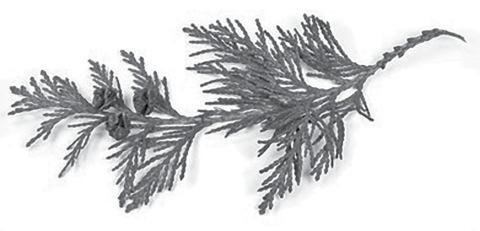



Recognition of the national occasion spreads through schools, the friendship centre and Paper Mill Dam Park
By Alexandra Mehl and Eric Plummer Ha-Shilth-Sa Reporter and Editor
PortAlberni, BC - On June 21 National Indigenous People’s Day was recognized across Canada, and in PortAlberni a number of events took place celebrating the region’s Nuu-chah-nulth heritage.
For many Nuu-chah-nulth-aht, Port Alberni is considered an urban hub for the surrounding west communities, and nearly one fifth of the small city’s population identifies as Indigenous.
June 21 began with recognition of Indigenous Peoples Day in local schools.At E.J. Dunn students and faculty gathered in a circle to recognize their place in Hupacasath and Tseshaht territory. With orange shirts glowing in the morning sun, a small lead circle was formed inside the larger one for a group of students and staff to sing našukʔaƛin, School District 70’s song that was gifted by Tseshaht memberAaron Watts.All appeared to know the words, joining in while clapping to the beat.
After this Gina Pearson displayed to groups of students how to fillet salmon that would be cooked in a barbeque to follow.After this Rene Little and Casey Sam taught students how to play Lahal, a traditional guessing game played by West Coast First Nations using bones and sticks.
By 11 a.m. festivities got underway at the PortAlberni Friendship Center, which holds a lunch every year open to all in the community. This year a variety of items filled the plates, including crab, salmon and bannok. Candy and popcorn were available outside while a band played, as young ones engaged in face painting and crafts.
Before lunch a prayer was given inside the Friendship Center byAhousaht elder Ciisma.
“It’s a good day today, a quu’aas day,” said Ciisma, referencing the Nuu-chahnulth word for people.
By midday the Tseshaht First Nation help a gathering on the reserve side of Paper Mill Dam Park. Vendors lined the park with beautiful treasures to be bought, while the House of Regalia held
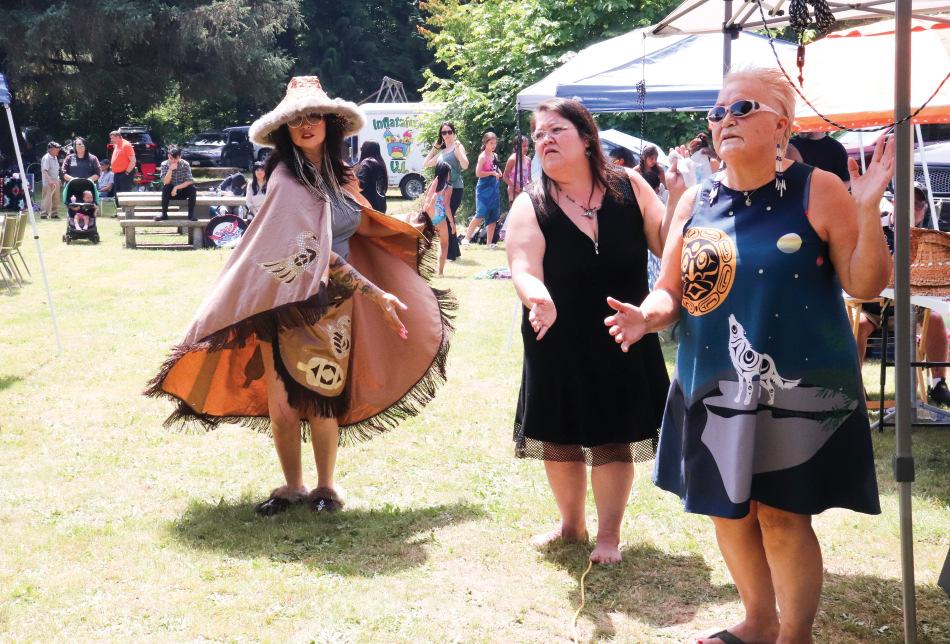
and dancing livened up the
a loonie toonie draw to raise money for PortAlberni street workers.
Laughter and chatter filled the park, while salmon, cooked with cedar sticks on a fire. Hamburgers, and hotdogs were also served. The afternoon welcomed community singing and dancing, alongsideAnswer2Dance Group with Tseshaht’s Jessica Sault.
Gail Gus, who coordinated the event, shared with Ha-Shilth-Sa that she always looks forward to events like this one. For Gus, National Indigenous Peoples Day is a time to showcase to non-Aboriginal community members traditional food, singing, and dancing.
“It’s a great way to celebrate and party,” said Gus, noting the event is open to all of PortAlberni. “It’s a day… where everybody can get together no matter where they’re at in life, and that’s important.”



On June 21 Huu-ay-aht citizens and friends gathered at Pachena Bay with culture, a barbecue lunch and stories
By Denise Titian Ha-Shilth-Sa Reporter
Anacla, BC –Ablanket of fog and a chilly breeze swept over the beach as volunteers built a fire so that they could barbecue salmon the traditional way, on cedar sticks over an open fire. Meanwhile, children played on the river bank building sand castles and flying kites as the sun slowly burned off the fog.
On June 21 Huu-ay-aht citizens and their friends gathered at their campground to celebrate National Indigenous People’s Day with culture, barbecue lunch, stories, dancing and togetherness. There were plenty of activities set up for the children to play while elders mingled at the picnic tables.
Edward Johnson Jr. served as master of ceremonies and got things off to a proper start with a prayer for the family that lost a loved one the day before.
Knowledge Keeper Qiic Qiica (Robert Dennis Jr.) acknowledged the Huuay-aht Beach Keepers, thanking the Peters women for allowing the people to gather on their beach for the day. He told the story of how the great earthquake and tsunami of 1700 devastated the Huu-ah-aht people and their home.
“That was the first time it came into the authority of a woman,” said Qiic Qiica.
Generations later, the Peters women, including Stella Peters, are recognized as Huu-ay-aht’s Beach Keepers.
“This is her beach, this is our home… it is paradise,” Qiic Qiica stated.
Guests were kept entertained with dances and stories before filling up with barbecue hotdogs and traditionally cooked salmon.
Elected Chief John Jack and his young son performed a bear dance for the return of a drum that he had misplaced. The Bear Dance, said Johnson, belongs to the Williams family.
Qiic Qiica also had to dance for the return of his walking stick.
While these dances are fun and entertaining, it was pointed out that dancing for the return of lost items teaches us to be more careful with our belongings.
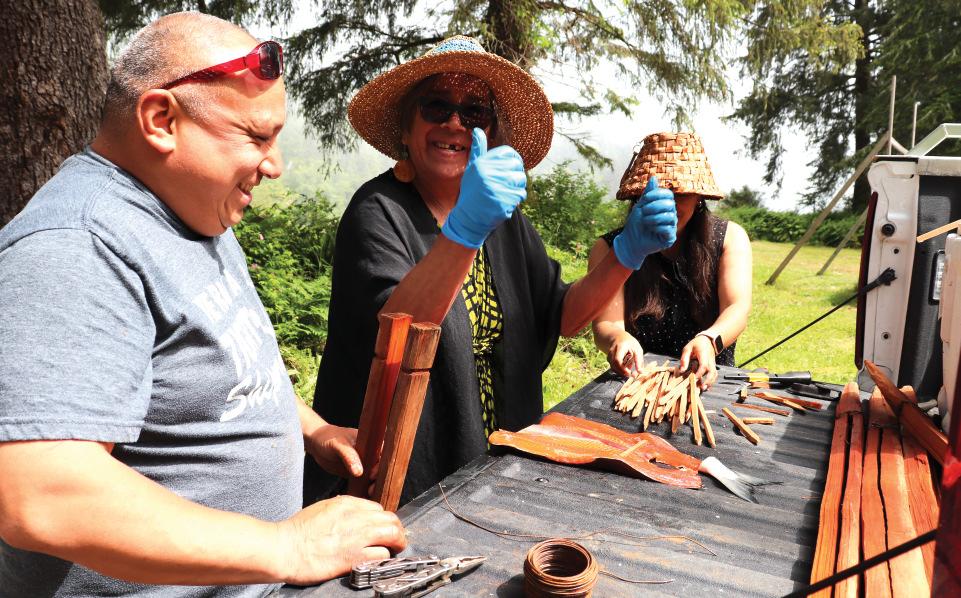
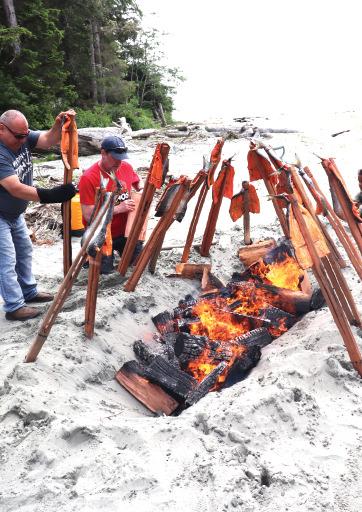
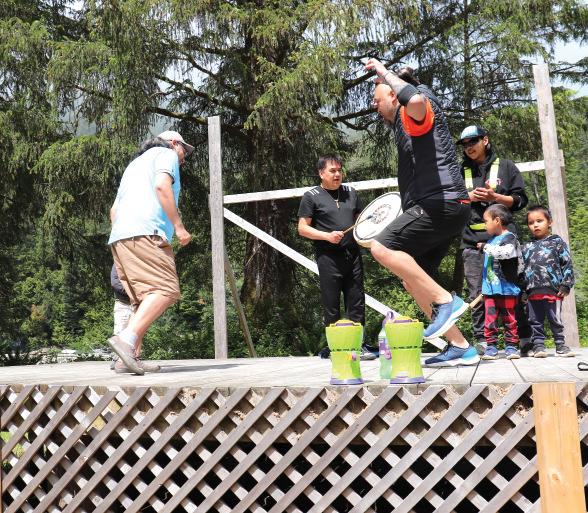
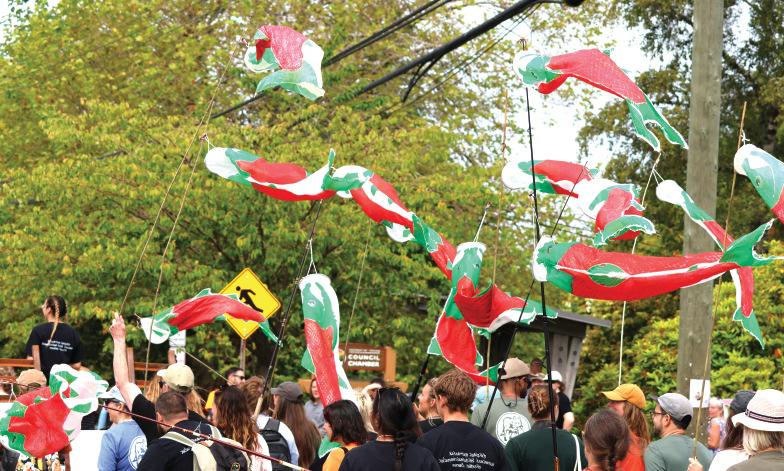
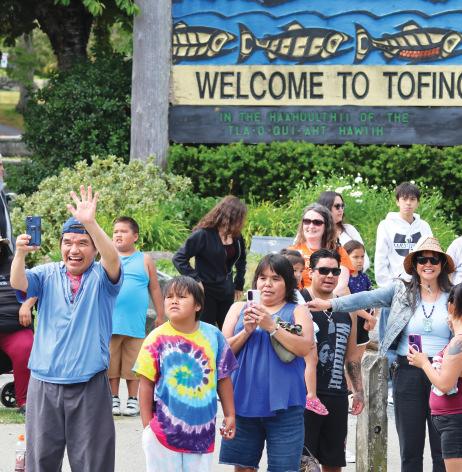
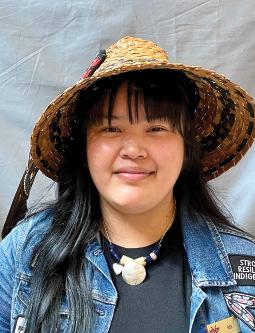



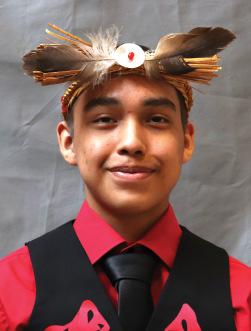



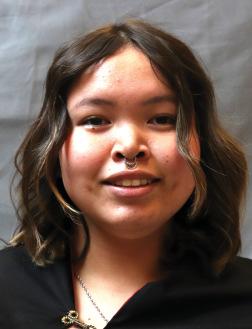

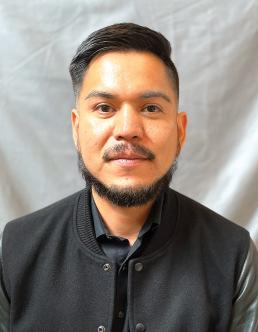



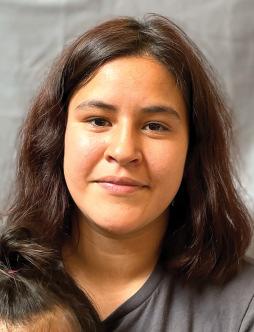
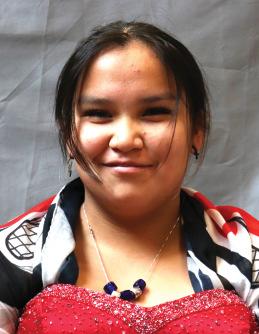




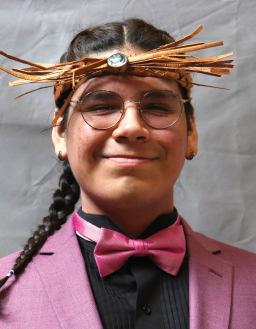








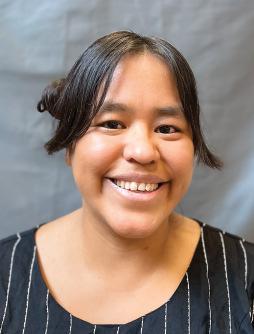

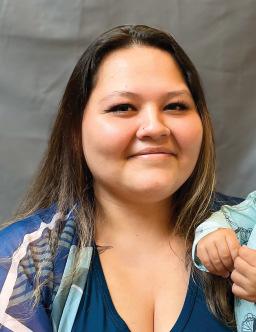
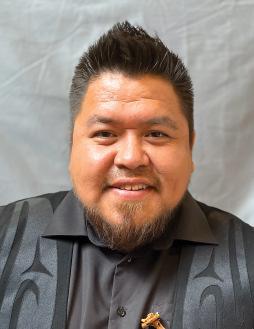
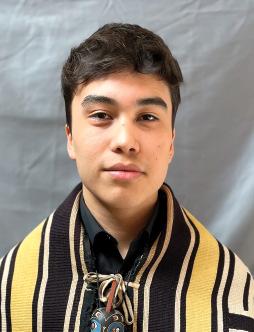






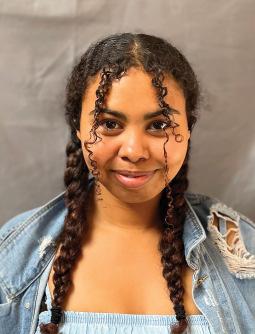
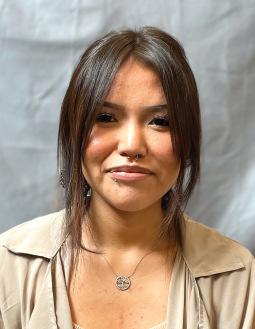
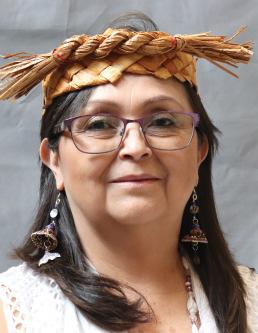

Nuu-chah-nulth students look back on the challenges faced in their Grade 12 year as they celebrate graduation
By Alexandra Mehl Local Journalism Initiative Reporter
PortAlberni, BC - With the days being warmer and longer, summer break is just around the corner, but for students in Grade 12, June also marks a larger milestone: the completion of their high-school journey.
For KatieAmbrose, a member of Ehattesaht with ties to Mowachaht, Hesquiaht, Kyuquot andAhousaht, she reflects with Ha-Shilth-Sa on her journey through school. Despite the challenges she’s faced during her time atAlberni District Secondary School (ADSS), including being a student there during the pandemic, she’s proud of making it to where she is now.
“It›s been a roller coaster getting through school,” saidAmbrose. “I’ve dealt with my own things and school got really hard.”
“There [were] a couple of hard years throughout high school and by Grade 11, I was just wanting to get out,” she said. But whenAmbrose was struggling, she reached out to the circle of support that surrounded her atADSS - some whom were people she least expected to help who came forward for her through her journey.
ForAmbrose her team of support consisted of a long list, including Nuuchah-nulth education workers, teachers, counsellors, workers from the career centre, other staff members atADSS, clinical counselling through Nuu-chah-nulth Tribal Council and the team at Youth Short TermAssessment and Response (Y-STAR).
“Teachers and counsellors are always there, and they just want you to succeed as well,” saidAmbrose, noting that they are “always really good” in providing support.
But through the struggles thatAmbrose experienced, family gatherings are what kept her strong, she said.
“I do believe family is medicine and they helped keep me strong,” she shared.
“I feel like in some way, at some point, I didn’t really care about school,” said Ambrose. “But a lot of the reasons why I’ve kept pushing is because I want to make my mom proud and be a role model
for my nieces and my nephew.”
For the young graduate, since Grade 9 she has always enjoyed psychology.
“It just really intrigues me,” saidAmbrose. “It’s really interesting.”
Ambrose’s choice of career has always changed, though her desire to help others has been consistent through her journey. Her mother, RubyAmbrose, even described her as a “natural helper.” Katie now aspires to be a registered nurse.
Ei-Ra Charleson of Hesquiaht, who graduated from EighthAvenue Learning Center, shared with Ha-Shilth-Sa that he completed roughly 20 classes this year to finish his schooling.
“That was my top priority this year was to finish school because I was like a year and a half behind,” said Charleson, who requested his graduation plan in February.
He shared that while he was placed on a graduation plan, he also was a part of the Chaputs program, a partnership between EighthAvenue Learning Centre, Usma, and the RCMP, where students learn to carve their own canoe paddles and go on canoe trips with elders.
“It was a really fun program,” he said. “I like being able to get out and go and paddle instead of doing my schoolwork.”
Though Charleson prefers getting out to paddle, his favorite subject is science because of the labs he got to do.
Every Friday at 6 p.m., Charleson met with a group for culture practice. He shared with Ha-Shilth-Sa that he is learning songs for his late-brother’s memorial.
“I’m my mom’s only son that lives with her,” said Charleson. “It was up to me to go and learn those songs and ask for help from other singers.”
“My culture played a role in helping me graduate with giving me something to look forward to in the week,” Charleson said. “Cultural practice has its way of healing you.”
Lisa Tremblay, a staff member at School District 70, shared with Ha-Shilth-Sa that Charleson is an “excellent role model, excelled in Nuu-chah-nulth language… and worked extremely hard this year.”
Next, Charleson would like to work for a couple years and then go to post secondary.
Katie’s mom, RubyAmbrose, reflected

on being a parent to five children.
“The parent role is so important,” said Ruby. “Family member as well.”
“Watching them all graduate and go through life, just seeing all the struggles that they did go through with loss and grief, and how real mental health is,” said Ruby. “Raising my family I learned along the way, more and more, with each child, how important that support is.”
“It takes a community to raise a child,” she added.
Ruby shared that Katie was surrounded by grandparents, uncles, and siblings who all “pitched in to help her succeed.”
Ruby reflected on how teachers and other workers in the school helped create plans for Katie that took into consideration what she was ready for and her
needs. The teachers and workers were always advocating for her, she said.
When Ruby encouraged Katie to do an assignment or something that she didn’t want to do, the mother always ended up helping her daughter.
“She was just trying her best to make sure I succeeded,” said Katie.
“It’s so important to say, ‘I have these things happening in my life, but that’s okay’,” said Ruby.
“Sometimes it doesn’t seem like you will have certain support staff that you need, but they’re always there,” said Katie. “It’s hard at first to ask for help, but once you do reach out and ask for help, there’s a lot more people that are there to support you than you think.”
Phrase†of†the†week:†Ha%ak%aqniš††muu>mumps†%uš†cak%up†%aah=iksup†%uuqwa†(DNA)†hiina>† ma%ayi>†h=uu†siyaa†(NZ)†+ayah=u%a+n†iš††h=iš†suk
Pronounced ‘Haa ugk ish hirs miss oh s chuck up Tha hurk sk DNAhe nul t my ee yii alth who saw yea (NZ) ear h just clu sup tle muc k stee’, it means ‘Our blood line is strong, new technology has linked us (DNA), to family and roots from across the ocean (New Zealand) and brought them home once again. Welcome home, we are glad to see you.’Supplied by ciisma.

A grand total of 26 graduates celebrate the completion of their time at the Nuu-chah-nulth elementary school
By Alexandra Mehl Local Journalism Initiative Reporter
PortAlberni, BC - Haahuupayak’s gymnasium was filled with proud family members, and vibrant decorations, as teachers, students and the surrounding community gathered to celebrate the accomplishments of the 2024 graduates that will be moving on toADSS in the fall.
“We have all gathered here to express our profound appreciation, respect, and admiration for some wonderful students,” said Ian Caplette, director of Education, Training, and Social Development at the Nuu-chah-nulth Tribal Council during the ceremony. “Please help me in welcoming the largest graduating class in Haahuupayak history.”
The gymnasium filled with cheer from proud family members. Twenty-six students entered the gymnasium to a song by their teachers. Caplette, then, called upon the students’leadership for one last time, as they were invited to sing and dance the welcome song.
One by one, each of the graduates spoke in Nuu-chah-nulth, also translating into English, introducing themselves, their nations and their family lineage.
“It was really fun,” said Riley Stewart, a graduating student, of the ceremony. “I enjoyed it a bunch.”
But most of all, Stewart enjoyed narrating the dance the students performed at the end of their ceremony.
Stewart’s favorite part of being a student at Haahuupayak is being able to participate in sports, with no tryouts. His favourite is basketball.
Similar to Stewart, Mia Dick Ross and Innisa Dick Ross shared with Ha-ShilthSa they will miss the sports teams the most as they leave Haahuupayak. But they plan to continue on with their love of sports.
Mia and Innisa’s list of sports teams they hope to be involved in atAlberni District Secondary include basketball, volleyball, rugby, and badminton.Aiden Dennis, another graduating student, hopes to also get involved with basketball and volleyball.
For Mia, her favorite part of going to school at Haahuupayak is “the culture.”

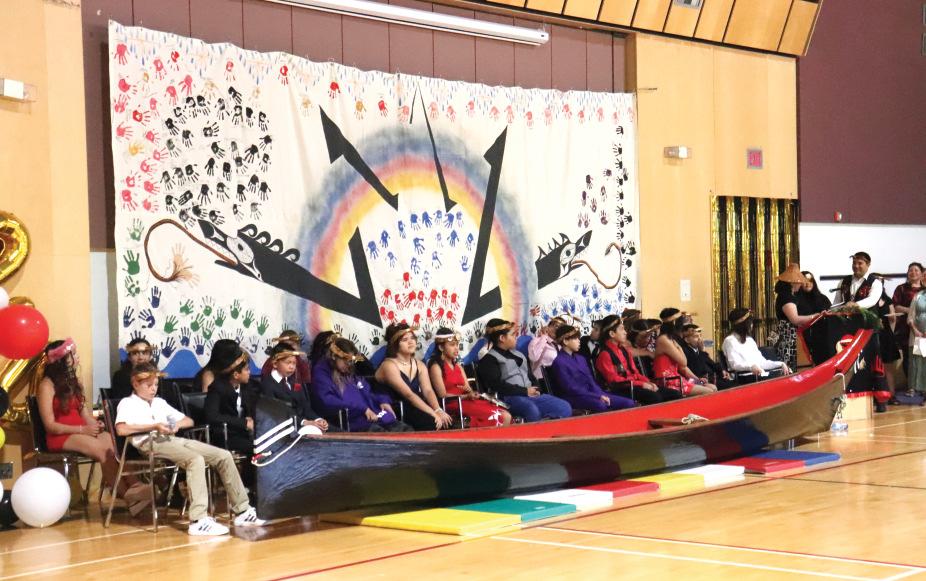
On June 20 the Haahuupayak gym filled with cheer from proud family members for the school’s graduation ceremony. This is the graduating class that Dontay Lucas would have been a part of. In honor of Dontay and his family, the ceremony began with a moment of silence.
Each of the soon-to-be Grade 8 students received a Haahuupayak graduation hoodie that have Dontay’s initials embroidered on them. The principal, Nancy Logan, shared with Ha-Shilth-Sa that Haahuupayak plans to plant a tree in their garden as a tribute to the young boy.
“This 2024 graduating class has indeed left a legacy, not only for being the largest graduating class with 26 strong graduates, but also for so many strengths and gifts that they’ve shared with us over the years,” said Logan, during the ceremony.
Logan said that the students have “demonstrated great resilience and determination, a passion for sports, art, reading, math, and science.”
“And as you will witness here today, their passion for their cultural teachings and their practices,” Logan continued. She assured that despite the challenges
the students may face in the future, they are never alone. Logan encouraged them to remember that their roots, culture, ancestors and family are always with them to guide them and give them strength.
“Remember all of the people in your life that do believe in you and know that you can do anything you put your mind to,” she continued.
“At Haahuupayak you are loved, cared for, supported, and believed in,” said one of their teachers, Ms. Greenwood.
“Haahuupayak will always be a part of you,” said Logan. “And you will always be a part of the Haahuupayak family.” Heečis
Ei-Ra Atleo Ahousaht Robyn Ambrose Ehattesaht
Andrew Clappis Huu-ay-aht
Vanessa Frank Tla-o-qui-aht


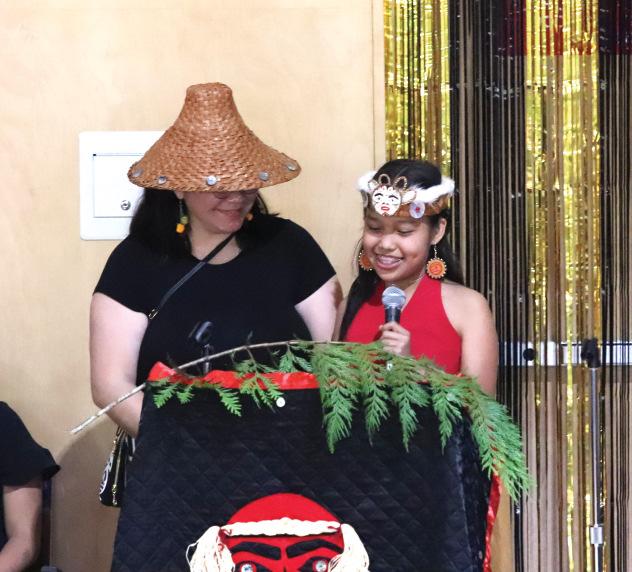

By Eric Plummer Ha-Shilth-Sa Editor
PortAlberni, BC - This June 74 students are graduating from the EighthAvenue Learning Centre.As they took the stage to celebrate this milestone a common sentiment was apparent: a deep sense of gratitude to the faculty for supporting them through their high school years.
Serving as an alternative to PortAlberni’s much larger high school, Eighth Avenue stresses the importance of forming close relationships with its students, fostering an adaptable educational environment according to individual learning needs.
“We need to make sure that we have that relationship with our students before we can even consider getting to the academic end of things,” said EighthAvenue
Principal Nick Seredick. “I think the high school does a tremendous job with all their students, they make a great deal of effort, but sometimes students just need a change of scenery and they need a different approach to education. I think that at EighthAvenue we do a really good job of personalizing education for our students, meeting them where they’re at, and then forming a relationship with them.”
The school recognized its most recent graduates on June 20 with an event held atAlberni District Secondary’s auditorium. Class valedictorian Gracie Martinez, whose heritage is from the Chiricahua Apache Nation of the southern United States, is grateful for attending Eighth Avenue, where she got “exceptional support” from staff.
“I truly hope that they are able to continue making this school the welcoming, accessible and educational environment it is for any individuals who need help the way I did,” said Martinez. “I will leave with only good memories of the staff and students.”
After receiving his diploma Julius Joe stepped up to the microphone. He admitted that at one point he wondered if he could finish, but he got through with the help of teachers and faculty.
“I think I was able to find who I really am,” said Joe. “I’m very happy that the staff there helped me do that.”
During his address to the audience Ian Caplette, the Nuu-chah-nulth Tribal Council’s director of Education, Training and Social Development, noted the supportive environment fostered at eighth Avenue.
“The place in and of itself looks like a school, but it feels a little different there,” he said. “It feels much more peaceful, it feels much more welcoming. It feels like,
deep gratitude to staff for their support

if I’m having a hard time I can sit down somewhere. Somebody may or may not come up to me ask me how I’m doing, ask me if I’m okay - but more often than not they do.”
At the ceremony School District 70 Superintendent Tim Davie admitted that there were interruptions during his high school years. He ended up finishing with help from an alternative learning centre in Nanaimo.
“I stand before you as an educated person, but I left in Grade 10, I left again in Grade 12. I went to Vast in Nanaimo, alternate school, and I had people in my corner as well who cared and took the time to support me,” said Davie to the graduates. “I hope you’re very proud. I hope you take a few moments to reflect on where you’ve been, where you’re at presently, and where you want to go in terms of your life.”
As they progress beyond high school, Seredick reminded the graduates that it will become readily apparent that there is far more to life than academic grades.
“In B.C. our education system is starting to value who you are at your core and your interactions with others, your problem-solving skills, if you walked your siblings to school on rainy days to make sure that they got there safe,” said the principal. “Have you been a good friend to someone? Value that. If you’ve
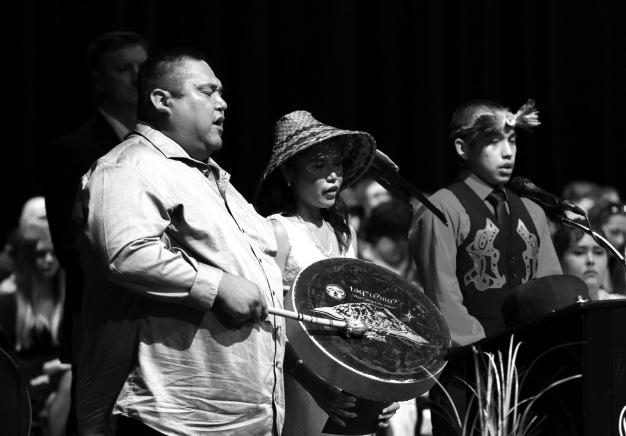

taken on a job to build skills and make money, give yourselves anA. If you’ve figured out why an engine hasn’t started and fixed it, value that too. There are so many things outside of the walls of the classroom that you can be good at. Life after graduation isn’t going to be giving you grades, rather you will need to continually assess yourself and set your next set of goals.”

For the time being, graduates like Julius Joe will be elevated by this recent accomplishment. While on the stage he saw faces in the audience, proud that he was “moving forward” with his friends.
“With the help of my teachers, the staff of ELC, the support from them, I was grateful I was able to do it,” said Joe.
“Thank you for believing in yourselves. We all need you,” added Caplette.

Ditidaht
KEmilyHaiyupis
K-3Athletic
2FannyAdams K-3hahopchu
7SeQuoiaMcGuire-Joseph Academic
10DakotaKnighton Athletic
10HaileyThompson Academic&Artistic
11KateEdgar Athletic
11DanielGeorgeJr. hahopchu
11DestinyPeltier Academic
11BarrySamuel Academic
11KirstaSamuel Artistic
11TessaScarlett-Charleson Athletic
Ehattesaht
KJewelMichael K-3Athletic
1JaxonHanson K-3Athletic
1MatthewJohn K-3Athletic&hahopchu
1JackJohn K-3Athletic
2JeremyJackJr K-3hahopchu
3BrandonJohnJr. K-3hahopchu
4JamesJohn hahopchu
6MabelAdams Athletic
6AmaleeHanson Academic
7MariaJohn hahopchu
11KalobJohn Academic&hahopchu
12RobynAmbrose Heechis
12DeniseJohn hahopchu
Hesquiaht
1WyattRedden K-3Athletic
2MaverickRedden K-3Athletic
4MalylaCharleson Artistic
10ShannonSabbas Academic
12Ei-RaAtleo Heechis
12JaydeJohnson-Moon Academic
12JorjaJohnson-Moon Academic
Hupacasath
9DanikaFoster Academic&Artistic
9MaddexxGeorge Academic
9IsabellTatoosh-MacLeod Academic
10TealaMcAnerin Academic
11MiaFoster Artistic
11VincentWilla Academic
Huu-ay-aht
3KylieRobinson K-3hahopchu
8SydneyNookemus Academic&hahopchu
12AndrewClappis Heechis
12LilyJohnson Academic
Kyuquot
1KassianJoseph K-3Athletic
6AyanaLeo Academic
8JacksonJules Academic
8NaomiVincent hahopchu
10BlaykeJohn Athletic
10GraysonJoseph Academic&Artistic
10CaitlynSmith Academic&hahopchu
11CalebHansen hahopchu
11(Adeline)ElisaJules Academic&hahopchu
12CalvinHansen Academic&BMO
12EvaSmith Academic&hahopchu
Mowachaht
1KameronSavey K-3hahopchu
2RosariaJohn K-3Athletic
2AbigailMark K-3hahopchu
6AndrewCallicum Academic
7DevonAmos Academic&hahopchu
7CaleighJack hahopchu
9DaveAmos Academic
9QuentinJames Academic&hahopchu
10TalisheAmos Academic
11BlazonJack Athletic
12SamaraAmos Academic
Nuchatlaht
1TluupinJohn K-3hahopchu
Tla-o-qui-aht
3TyrellFrank K-3hahopchu
5TraceyAmos-Frank Athletic
5RashawnBarker hahopchu
5MelissaFrank Academic&hahopchu
5KatinaThomas Academic
6MasonFrank Academic
6HelenMartin Academic
8TaylorFrank Academic
10WiinukMartin Academic&hahopchu
10HaydenTom-Charlie hahopchu
11HannahFrank Academic&hahopchu
12VanessaFrank Academic&Heechis
12McKaylaGeorge Academic&BMO
12StephenJack Academic
Toquaht
9LindaWilliams Academic
Tseshaht
KLanaleyHassall K-3Athletic
4ToddGoodwill Artistic
4RileyHassall Athletic
4AnderLucas Academic 4AlannahPeters hahopchu
4KessaWatts Academic
5DawsonBill Academic
5TatiannaPeters hahopchu
6TessaAuerbach Academic&Athletic
6DesiderioGomez-Charles Academic&Artistic
6GertrudeLucas Academic&hahopchu
6SophiaMack Academic
6RiverLeePoirier Academic
7SolomonWatts Academic
8EmeryAuerbach Academic
9KateAnderson Academic
9MariahNelson Academic&hahopchu
10Alexander Fred Academic 11AngeleneBarney Academic&hahopchu 11RaelynnJohnson hahopchu
11Tia-PaigeWatts Academic&hahopchu
12KierisBraker-Patterson Academic&Athletic
12JasmineFred Academic&Artistic
12MatthewFred Academic
12DevinJohnston Academic
12RickieMack Academic
12KaylenPoirier Academic
12JaylaSabbas Academic
12KelcieSam Academic&Athletic Congratulations 2024 Graduates!
Best wishes on your future endeavours.
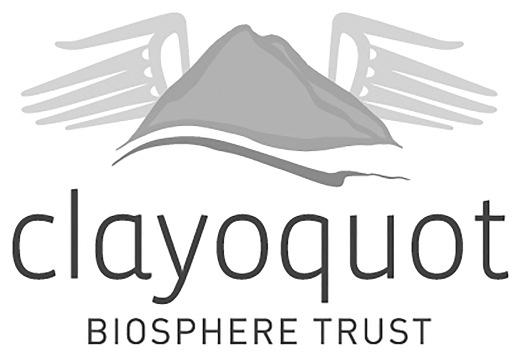
Hello everyone. Hope all is going well in your communities. Summer solstice came and it is time for fishing, gathering cedar and grasses, berry picking and enjoying the warmer temperatures. I know there have been more losses in our communities and my heart goes out to the families, friends and communities.
June is grad month and I have been seeing all the pictures posted from various First Nations, institutions, and our own NTC grad and scholarship ceremonies. Agreat time of pride in our families and communities as to our members’achievements in education and training, knowing that our leaders for tomorrow are obtaining skills that we can use in our communities in all areas of our governance - be it education, childcare, health, fisheries, resource management or infrastructure. It’s awesome to see the excitement in our graduates’faces as they finish one part of their lives and move onto others. Traditionally, our learning was on the land and water as everyone learned how to harvest, gather and to look after the forests and river to make sure everyone was looked after. We had many other life lessons, of course, in making baskets, clothing, tools and preparing for the various seasons. These on-the-land teachings still go on with various nations and families, and they are important to note as well as those successes in graduating from high schools and other educational institutes. Whatever the accomplishment, it’s good for us to celebrate our members for things they have learned.
The Nuu-chah-nulth Council of Ha’wiih Forum on Fisheries had two days of meetings. As usual, there was one day of internal discussions and one day of meetings with the Department of Fisheries and Oceans. Discussions ranged from habitat protection, run sizes and information. Efforts in the northern region of the Nuu-chah-nulth on Salmon Parks continues and is a great effort on restoration and rehabilitation of fisheries habitat. Of note was concern that the federal government ensures they do not provide Métis in B.C. the right to a fishery as they do not have any fishery rights. ArecentArticle by Métis lawyer Stephen Mussell, states:
“The first is that the Métis Nation is an Indigenous people, but we are not Indigenous to B.C. west of the Rocky Mountains. Save for those few Métis who have been accepted into First Nations in B.C. through marriage, adoption, or some other valid legal, social, or political means, Métis in B.C. are settlers, even if their families, like my own, have resided in B.C. for multiple generations.
“The second is that First Nations in B.C. are the proper inherent and constitutional rightsholders within their territories. They have applied and exercised their inherent laws, legal systems, systems of governance, and jurisdictions throughout the entirety of their territories prior to contact and continue to apply and exercise them throughout the entirety of their territories today.”
It’s important Canada recognizes and implements ourAboriginal and treaty rights to the fishery, both domestic and commercial. We don’t have to share rights with a group that doesn’t have these rights.
The Heritage Conservation Transformation process has begun its work again to make the kind of changes First Nations in this province want to protect and manage their cultural, heritage and sacred and spiritual sites. We hope this process will bring the B.C. government to the kind of transformation that is necessary to be in

line with the Declaration on the Rights of Indigenous PeoplesAct.
B.C. is heading into an election, so from Sept. 21 to sometime in December when a cabinet is sworn in, little can be done at negotiations tables. It is a frustrating time as you basically have to put things on hold, before and after the elections. So the heritage table and other tables dealing with the provincial government - either making changes to legislation or regulations or negotiating treaties or reconciliation agreements - are put on hold.
Efforts continue to be made in developing capacity in building and operating clean energy projects, and webinars are being offered to help with this. From choosing sites, your team of engineers, environmental, financial and legal can choose partners, while negotiation tactics are offered in these webinars. I have presented at two of these webinars.
Jeannette Watts, a long-time employee with NTC in nursing, has retired. She has been very involved with every aspect of nursing at NTC, helped get us through the pandemic and other health issues and has helped in the research being done out of our health department. We will miss her wisdom and expertise and wish her the best in her retirement. We cannot thank her enough for everything she did for the Nuu-chah-nulth people.
Directors meetings are held on the last Tuesday of the month. Meetings are available to watch on the Ha-Shilth-Sa Website. Reports are made from the president, vice president, executive director and various committees. We have presentations from various groups from time to time as well. At our last meeting we had Dr. Roger Boyer presenting findings from the COVID study that we conducted. It is a unique study that will provide valuable information on what we learned about COVID that will help in the future. We also heard from the Olam Iisaak Foundation and how they can work with First Nations on protected and conservation areas. We also agreed to sign a research affiliation agreement with Simon Fraser University that will allow us to work with them on proposals and get administrative dollars to support the research we do in health. We have done several projects with SFU and have found them to be good partners.
Upcoming over the summer is the elders conference in Vancouver. Over 1,000 elders attend and there are information sessions, entertainment and self care offered. Hope all that go enjoy their time there. Wishing everyone a good summer and hoping that there is a lot of fish in all our communities to put away for the winter.
Respectfully,
Cloy-e-iis,
Judith Sayers

2024 Northern Region Games
July 5th – 8th, 2024
Houpsitas
The Ka:’yu:’k’t’h’/Che:k:tles7et’h’First Nation would like to extend an invite to the Norther Nations: Ehattesaht/ Chinehkint, Mowachaht/Muchalaht, Nuchatlaht in joining us for the 2024 Northern Region Games held in Houpsitas. No fireworks. Drug and alcohol-free event, bring your own chairs. Curfew 11:00 pm. Zero waste event –please bring your own plates and cutlery.
Nuu-chah-nulth Baby Group
Every Monday
CYS - 4841 Redford Street, Port Alberni
10am-12pm. We offer Prenatal and infant development information, special guests, snacks provide and $20.00 food voucher per family. Referrals when needed. NTC Nursing and Doula’s 250-724-3939. Enter from 4th avenue side, building with orange stripe.
Girls Group
Every Tuesday
Usma culture space, PortAlberni 5:00pm-7:00pm Girls ages 13-18. Need



a safe space? Want to express yourself? Looking to learn to bake and cook? Do you enjoy doing crafts? Come join us for fun activities with food and refreshments every Tuesday!
Eating in Balance
Wednesdays
PortAlberni Friendship Center –Treasure our young ones childcare center
Group works together starting with planting seeds up until preserving the food. Participants will receive a $10.00 grocery coupon that can be used at Quality Foods and Buy Low Foods. Open to all families with children 0-6. To register please contactAmber at 250-723-8281 ext. 233 or aflaro@ pafriendshipcenter.com or on FBAmber PAFC
Cultural Brushings with Quu asa
Every Friday
RedfordAdministration Building, Port Alberni
9:00am-12:00pm Cultural Brushings in support of the Tseshaht Community. If you have any questions, please call Leanne Harding,AdministrativeAssistant 250-724-1225

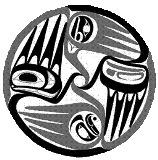
Need work experience? The Port Alberni Friendship Centre is looking for interested applicants for various positions. Call 250-723-8281





A new peer-facilitated collective will support those working through loss of a loved one due to a drug overdose
By Alexandra Mehl Local Journalism Initiative Reporter
PortAlberni, BC - TheAlberni Valley is now home to a new peer-facilitated bereavement group, held on the last Monday of each month, to support those who have lost a loved one to the toxic drug crisis.
Healing Hearts bereavement group, which is sponsored by an organization called Moms Stop The Harm, is facilitated by Maureen Therrien-McKinnon, who lost her son to the toxic drug crisis.
“I really wanted to reach out to other parents and family members and friends in the community that have lost somebody,” she said. “I want it to be a safe place where we can talk about it and there’s no judgment at all.”
With the group meeting once a month,
Therrien-McKinnon shared that people can expect to have a space to talk freely about their story and their loved one.
“It helps us actually deal with all the emotions that come up, because every emotion that is known to mankind comes up in grief, unfortunately,” said TherrienMcKinnon, noting that sharing each other’s stories is a way to process grief.
“People can speak if they want to or not,” she assured. “If they’re not comfortable, but they just want the support, they can just still come… hear what other people have to say.”
Therrien-McKinnon said the group follows in a structured format the feelings associated with grief and how individuals are dealing with it.
“We need to be able to grieve in a healthy way - believe it or not, grief can be healthy - and to find ways to mitigate a lot of shame and guilt that’s around that,” she said.
Therrien-McKinnon has facilitated many peer-supported grief groups based out of Ucluelet, having also lost her husband from a logging accident at a young age.
“You do form a bond with people when you’re in a group like that, and that bond can last forever. It doesn’t matter what walk of life you’re in,” said TherrienMcKinnon. “You have a connection with each other that is the bond that really supports us to keep moving forward.”
She shared with Ha-Shith-Sa that the group can be a space to continue to talk about their loved one, even after family and friends continue to move forward after the tragedy.

Healing Hearts bereavement group, which is sponsored by an organization
fourth Monday of every month at the Kuu-Us Crisis Line Society.
“Quite often, what happens is family and friends just only talk about it for a while,” said Therrien-McKinnon. “Yes, we have to keep moving, but we don’t just get over it, we probably never will when it’s our family, [and] when it’s our children, especially.”
“Mothers don’t get over the loss of a child, you do learn how to step forward, eventually and move a little bit beside it, but it will always be there,” she said. “We found that being together and processing those feelings is really important.”
The toxic drug crisis continues to impact communities throughout the province significantly with 763 deaths in 2024 due to substance use, according to the most recent BC Coroner Service report. For theAlberni-Clayoquot region, there has so far been a reported 10 drug deaths in 2024.
But, it is significant to note that, according to the report, the death rate due
to toxic drugs has decreased by 24 per cent when comparingApril 2023 toApril 2024.
“Losing a loved one to the toxic drug crisis is often an unexpected and sudden loss. It’s [a] difficult loss that can be silent and lonely in grief, one that may come with feelings of guilt and shame, and has stigma attached to it,” said Sanne Van Vlerken, Teechuktl Mental Health manager, in an email to Ha-Shilth-Sa. Van Vlerken wrote that a peer support group can be a safe space where people can relate to one another through their grief and loss.
“[P]eople do not have to be silent in their grief, where they can be understood and accepted without the fear of stigma or feelings of guilt or shame,” she wrote.
“Asupport group can help people with the pain of getting well with people who care, accept, and understand.”
Therrien-McKinnon shared with Ha-
Shilth-Sa that peers from the group can be referred to counsellors throughout the Alberni Valley who are trained in the complexities of grief.
Teechuktl Mental Health can also “provide grief and loss support through the counseling and non-insured mental health benefits program, Quu’asa wellness program, and harm reduction outreach support,” wrote Van Vlerken.
Nuu-chah-nulth-aht can also reach out to organizations such as Kuu-Us Crisis Line Society, the Kackaamin Family Development Centre in PortAlberni and the Tsow-Tun Le Lum Society in Duncan.
“I do hope that people would be feeling safe enough to reach out because it’s a difficult kind of a loss,” said TherrienMcKinnon.
Meetings will be held on the fourth Monday of every month at Kuu-Us Crisis Line Society’s meeting room at 6:30 p.m., with the next being June 24.

New non-profit seeks to get pet population under control and make animals healthier in remote communities
By Denise Titian Ha-Shilth-Sa Reporter
Clayoquot Sound, BC –Afounding member of a network serving coastal communities in Clayoquot Sound says that Canadian Indigenous communities are underserved when it comes to government funding for animal welfare programs, and this contributes to the problems seen on many reserves.
James Rogers co-founded the CARE (CoastalAnimal Rescue & Education) Network. He’s spent the last 12 years building animal welfare supports with volunteers who go into outlying communities to assist with animal care concerns and to remove unwanted pets. Based in Tofino and Ucluelet, the CARE Network serves those communities as well as First Nations villages in the area, including Ahousaht and Tla-o-qui-aht reserves.
The network assists First Nations with bylaw enforcement work around animal control and they rehome unwanted pets. They have arranged wellness and spay/ neuter vet clinics on reserve over the years, which has helped - but it’s not enough.
There are chronic challenges for pet owners living in remote coastal communities, particularly those with low incomes and lack of transportation. Even though veterinary care is considered an essential service, outlying communities remain underserved.
It was the COVID-19 pandemic that shone a spotlight on the lack of veterinary care in remote communities. In British Columbia, animal care was deemed an

Abarge carrying a mobile veterinary clinic operated by the CARE Network heads
in the remote community. essential service.
According to Rodgers, Tla-o-qui-aht administration secured a grant for improving resilience following the COVID-19 crisis. Communities were faced with isolation and had to find creative ways to be self-reliant when the world came to a virtual halt at the height of the pandemic.
“We are now involved in starting a new organization, that has only Indigenous nations as its membership, to shift the 150-year inequitable status quo of how

the federal and provincial governments allocate animal-related community safety resources,” said Rodgers.
The new Indigenous-led organization will be calledACCESS, which stands for theAnimal Care & Community Empowered Safety Society. It is intended to fill gaps that one other major organization, the BC SPCA, is not reaching.
In existence for 129 years, the BC SPCA has more than 40 branches and veterinary facilities in the province. Emily Thorner of the BC SPCAsays they do not receive regular annual funding from the government, however, they sometimes receive grants for capital projects. Thorner says the BC SPCArecently received $12 million to cover the cost of four building projects.
The BC SPCAcontracts with municipal governments, receiving fees for animal control services. They are also supported by donations and fundraisers.
“We want to invite any nation interested in improving their community health and safety, as it relates to animal challenges, to get in touch and hopefully become a member ofACCESS,” said Rogers, noting that joining the cause is free. “With our non-profit animal service provider partners, like Mission Pawsible,ACCESS will continue to help develop a non-profit veterinary sector in B.C. to bring veterinary resources to chronically underserved communities.”
The goal, says Rodgers, is to get the pet population under control and bring animals to a healthier condition.
According to Rodgers,ACCESS will be a place First Nations can bring their perspective and take part in decision-making
at higher levels. The new society seeks to increase access to animal-related resources for remote communities, especially Indigenous communities.
“We want to invite any nation interested in improving their community health and safety, as it relates to animal challenges, to get in touch and hopefully become a member ofACCESS,” said Rodgers.
“As a collective force, we will disrupt the inequitable status quo and enact the changes needed to keep all members of our communities, whether they have two legs or four, safe and healthy, as our future wellness is intertwined.”
Nuu-chah-nulth First Nations representatives will introduce the idea at the July 2024Assembly of First Nations meeting in Montreal. They will be seeking Canada-wide First Nations support for the organization. The resolution, titled “ANational Strategy onAnimal Care and Control in First Nations”, will seek to gain support of delegates at theAFN level.
“For now, our focus is on British Columbia but we hope to see it go nationwide,” said Rodgers.
TheACCESS board of directors includes Dr. Emma Jackson, an Indigenous veterinarian based inAlberta.Also on the board are Shawn Quick of Tla-o-quiaht as well as Dr. TaraAtleo and Deputy Chief Sabrina Campbell ofAhousaht.
To learn more aboutACCESS or to join, visit www.increasedaccess.org
ACCESS is a registered BC non-profit organization with federal charitable status and will issue tax receipts for donations. Email info@increasedaccess.org for more information.


By Eric Plummer Ha-Shilth-Sa Editor
For three days of music up to 1,000 are expected at Pachena Bay, where a endees are urged to leave no trace able for those who don’t want to camp, providing that verification is shown of accommodation in Bamfield.
Anacla, BC - In recent weeks a group of whales have been in Pachena Bay, their backs occasionally emerging from the water, spouting bursts of mist into the Pacific air. For those fortunate to witness them from the shore, the whales serve as a reminder of the natural majesty that is integral to the site by the Huu-ay-aht village ofAnacla.
“That’s definitely the secret sauce,” said Ben Howells of the whales, who is the founder and head organizer of the upcoming Pachena Bay Music Festival. “The hidden agenda in my heart sometimes is connecting people with land.”
From July 19-21 the Pachena Bay Music Festival returns to the site for the third official year, bringing nearly 60 confirmed performers from across the West Coast and various corners of the world for a mix of electronic, DJs, blues and folk music.
The festival will also be taking over the Huu-ay-aht’s Pachena Bay Campground for visitors to stay over the course of the festivities.Approximately 800 festival goers are expected, and including staff, performers and locals, organizers are preparing for as many as 1,000 over the weekend.
“I think this will probably be our limit this year,” said Howells, who has worked to find the right balance between drawing a high volume of people while not compromising the natural location or the experience of the event. “If we were not being responsible in our approach, it would be very easy for us to oversell this

event.”
The festival is sold out, with a waiting list of 450. Unlike other multi-day musical events, only three-day camping passes were available to the general public, a measure by organizers to ensure a respectful crowd gathers at Pachena Bay.
“When people aren’t committed to that full weekend, they tend to be messier, a bit more disrespectful,” said Howells, who has also put on the Cumberland Wild andAtmosphere festivals, among others. “Weekend passes ensure that people really set in and really pick up the vibe of what’s going on, and it also makes for less vehicles on the road.”
Parking is being offered off of the site, with free shuttle buses available in Bamfield. Leading up to the event, a limited number of weekend passes are avail-
These measures met the concerns of the Huu-ay-aht First Nations, said Chief Councillor John Jack.
“We’ve been able to bring up our concerns regarding things like parking and traffic, and we’ve found good solutions that work for everyone,” he said, noting that the organizers have shown sensitivity to what the Huu-ay-aht community requires. “We’ve had good interactions with Benjamin.”
The event also presents an attractive economic opportunity for the Huu-ayaht Group of Businesses, which relies on forestry for the majority of its annual revenue.
“Huu-ay-aht has been looking to diversity its economy, and part of that is attracting tourists,” said Jack.
For the upcoming music festival, it won’t be the first time for many of the visitors. So far 68 per cent of the event’s attendees are returning festival goers, a dynamic that Howells finds helpful in fostering the right environment over the three days.
“When you have a larger percentage of the humans that know what to do, to a degree, they tend to self-meditate,” he said. “The problem is, if you have a festival that goes too quickly or you have a festival that markets too broadly, you end up with too broad of a demographic.”
“Please consider this event being 60 per cent remote camping trip and 40 per cent music festival,” reads a message from organizers on the festival’s website. Attendees are urged to bring out every-
thing that they take in, including garbage, as there are no trash receptacles at the festival.
“Ultimately, it’s pack out what you pack in,” said Howells.
The endorsement of the local community has been critical for the event, which originated in 2021 when a few Pachena Bay campsites were booked for a dance party of about 60 people. Even on this small test scale, locals fromAnacla were invited.
“We wanted to see what the vibe was and see how our crew connected with campground crew,” said Howells.
This year only Bamfield residents can buy day passes, whileAnacla residents get in for free.
Festivities are planned to get underway at 5 p.m. on Friday, July 19 with a parade from the campground office, something that has become a tradition for the festival. This opening procession will be led by the Babyface Brass band, who are set to lead the march to the beachfront stage for an official welcoming by the Huu-ayaht.
“There will be meaningful participation from Huu-ay-aht at the beginning of the event,” said Jack. “One of our cultural experts, and one of our members of council, Edward Johnson, will be involved in that directly.”
Others with Huu-ay-aht ties scheduled to take the stage include Djama (Aya Clappis) and Hinatinyis, who will also be interjecting Nuu-chah-nulth content into the event throughout the weekend.
“She’s going to do a little bit language for the crowd in between events,” said Howells.
By Alexandra Mehl Local Journalism Initiative Reporter
Vancouver, BC - Tleḥpik Hjalmer Wenstob, a recipient of the 2022 YVRArt Foundation Scholarship, has two steambent hinkeets masks on display at the Museum of Vancouver in their “Creation Stories: Carrying Our Traditions Forward” exhibit, which opened on June 19.
“Being Tla-o-qui-aht and being Nuuchah-nulth, I really wanted to make something that stayed very true to our tradition,” said Wenstob, noting that he modeled the pieces off of hinkeets masks he’s seen in museum collections. “[I] wanted to make these and honor, and kind of homage to those pieces that are no longer with our people,” said Wenstob.
Wenstob shared that hinkeets masks continue to be danced in Nuu-chah-nulth culture, and chose to carve two of them because they are always danced in pairs.
“The paint, the colors, they’re all inspired from these old pieces in the museum collections, of course, with my own artistic spin on them,” Wenstob shared with Ha-Shilth-Sa.
Wenstob and nine other emerging and mid-career Indigenous artists each received scholarship awards of $5,000 to “pursue their art practice through mentorships, education or community focused art projects.”
For Wenstob, he applied for the scholarship aspiring to learn a new skill: steam bending.
Steam bending is a woodworking technique where steam is used to make the wood more pliable and easier to shape. Once the wood cools, it maintains the
shape that it was worked into.
For Wenstob’s process, he shared with Ha-Shilth-Sa that he first carved the masks before steaming them.
“This was because I thought the steaming process would create the masks to be very delicate and I wanted to make sure that they wouldn’t have too much force on them from carving them after,” he said. “Once they were steamed, I let them sit and dry for quite a while before finishing them, going back in and painting them.”
Over a decade ago, Wenstob was awarded for the very same scholarship, which partners artists with mentors. For both projects, his mentor was his grandfather.
But for Wenstob, creating his artwork is interwoven with his entire family including his grandparents, parents, brother, aunt, wife, and two children.
“My entire family has always supported my carving and creating, and everyone’s been involved in pretty much every project I do,” said Wenstob. “I don’t think I could do it without them and I honestly don’t think I’d want to venture into an opportunity where I had to create without them.”
He notes that everything that he takes on, including Cedar House Gallery, which is owned by Wenstob and his family, is there with them representing four generations.
Prior to the Museum of Vancouver show, Wenstob’s masks were displayed for one year at the Vancouver International airport where international, national, and domestic audiences could view his work.
“Now, them being at the Museum of Vancouver really opened the audience up

Museum of Vancouver Photo
Tleḥpik Hjalmer Wenstob has two steam-bent hinkeets masks on display at the Museum of Vancouver in their “Creation Stories: Carrying Our Traditions Forward” exhibit, which opened on June 19.
to be able to see the pieces in a different space,” said Wenstob.
Once the Museum of Vancouver exhibit comes to a close, Wenstob plans to showcase the two hinkeets masks at Cedar House Gallery, based in Ucluelet.
But what is most exciting for the artist is that currently he has his work showing in five different locations: Museum of Vancouver,Alberni Valley Museum,
Clayoquot Biosphere Trust office, Bill Reid Gallery in Vancouver and theArt Gallery of Greater Victoria.
“For a Nuu-chah-nulth artist living at home, at Long Beach, and being able to have my work showing in so many different communities across the lower end of British Columbia, it’s pretty exciting,” said Wenstob.
